Exhibition May / June 2017
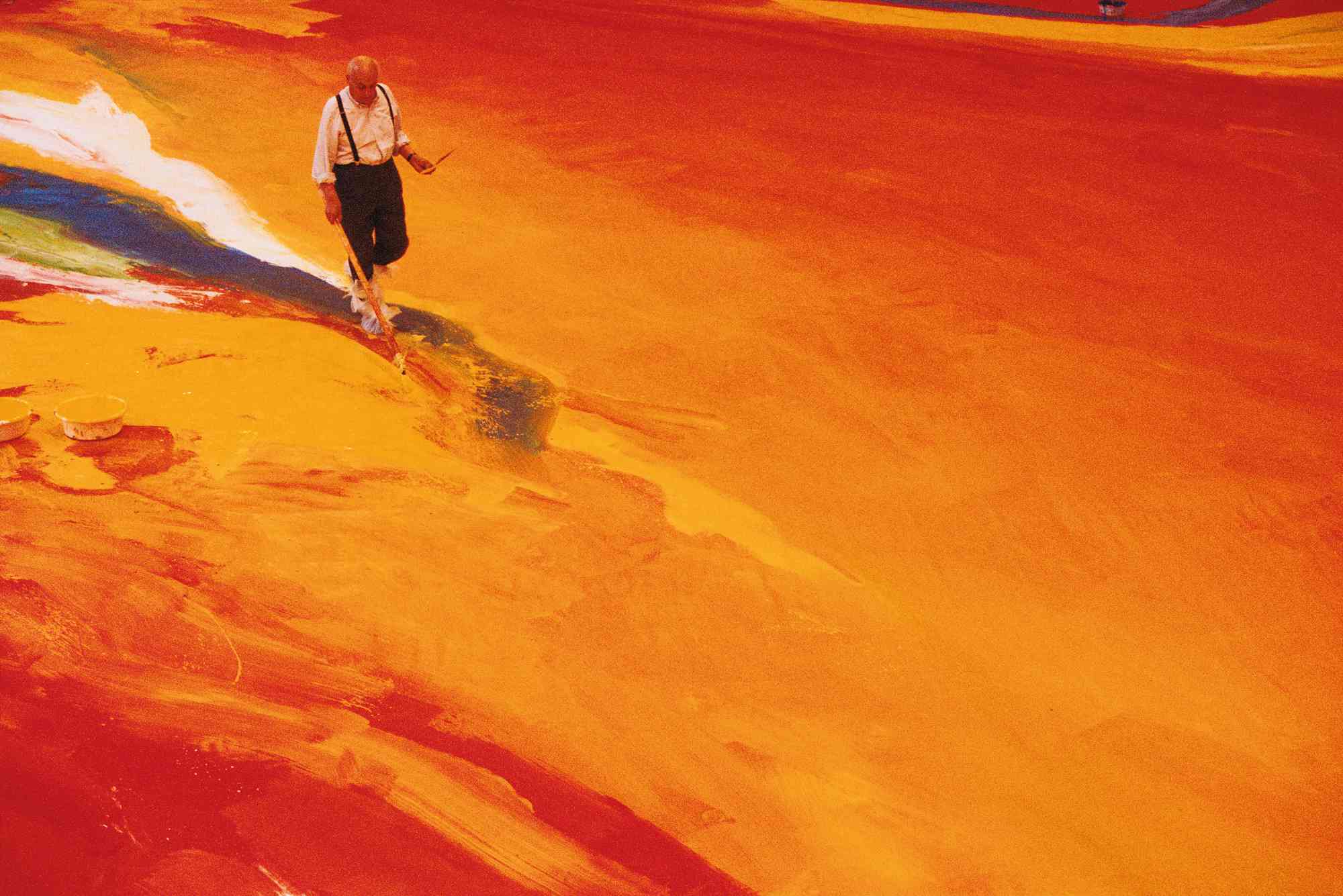
Olivier Debré painting the stage curtain of the new Opera House of Shanghai, 1998. Photo Marc Deville
Next page:
A painter of broad expanses, Olivier Debré’s work has always been imbued with incredible vitality. After painting the stage curtains of the Comédie-Française in Paris, a public commission in 1987, and the new Opera House of Hong Kong, commissioned by the Louis Vuitton Foundation for Opera and Music in 1989, just one year before his death, the artist painted the stage curtain of the new Opera House of Shanghai (46 x 72 ft.) in 1998, assisted by two Chinese painters: Jing Shijian and Xu Jiang. Debré’s work was once again a bridge between the East and West.
Introduction
It is in encountering a work that admiration for an artist is born, for us it was seeing a large “Loire Bleue” by Olivier Debré whose colour vibration still affects us. A blue that is at times pink, orange, green, grey; in short, like in all the large Debrés of his maturity, a colour that is also a prism revealing its composites to the informed eye, vibrating in the light, an intrinsically lively abstraction behind the apparent simplicity of its means.
In his paintings Debré communicates impressions to us created by light, fleeting and changing, but in this fugue there is a permanence: that of his profound communion with nature. The same communion as Rousseau recalling his wandering in the forest where deistic sentiment was born in him. Spinoza’s communion seeing in all of nature a divine hand.
Debré’s work revolves around his reception of Creation whose sensation he transcribes physically in his paintings:
In the “Signes-personnages” of the 1950s, his journey begins — like for all of that generation — with a debt to Cubism and to Picasso, and achieves — for the best of them — a personal language: nor does Debré tackle the visual or material expression of the human, but its phenomenon. He refines, releases to retain only its essential: the energy of the sign.
This seminal series would lead him to quasi monochrome works at the end of the 1950s where the sign invades the entire canvas ready to overflow from it to encompass all the surrounding space.
The emblematic series of the “Loire” from the 1960s, would allow Debré to develop his colour vocabulary by using a new stimulus, that of water, the river. Here, too, he simplifies, focuses on the essentials: no more banks, no more margins, only water. Thus his large works dominated by one colour would translate this phenomenon: blue but also green, red, brown, white, all in fact the creations of several layers which give these paintings a depth, a life that cannot be found anywhere else.
Today, it’s clear that Olivier Debré occupies a very specific place in Post-war French and European painting. The only one of the Gesturals and the Minimalists to develop a study of the vibration of colour which cannot be found elsewhere than in the United States at that time. He alone would maintain in all his work the alliance that is so difficult between force and poetry.
Interview with Daniel Abadie
Art historian, curator at Musée National d’Art Moderne, director of Musée du Jeu de Paume, writer of many books about Modern Art and Contemporary artists.
Daniel ABADIE: You began first of all by studying architecture?
Olivier DEBRÉ: I was admitted at 17, just after leaving school.
And you studied architecture without qualifying?
There was the interruption of the war, and at the time I was painting. I painted a lot while I was at the Beaux Arts.
Why had you chosen to become an architect?
First of all because I was fascinated; and then my father thought it was more reasonable. Actually, I combined the two things and in fact I continue to combine them. As a child, I combined architecture, painting, sculpture. For me, they were all the same thing, it was a way of being as opposed to medicine, law or maths. The Beaux Arts formed a whole. Architecture as much as painting.
Was it an anti-social attitude?
Oh, no. Not at all. The Beaux Arts is very social, anyway.
I felt in my element there, a way of thinking beyond words, beyond numbers. I felt I was made for something else, that I was made for painting, and had felt this since my childhood. While a small child, I always painted and always sculpted. This seemed to be my natural way of expressing myself. I was at ease, I always won the first prize in drawing.
Why did you not try to qualify then as an architect?
It was the circumstances of the war: I was injured andstopped for a long time, I got married, and then the painting was going very well. At that time I was very young, but finally I found myself opposed to the Beaux Arts. The ideas I had in architecture and in art in general did not correspond to the teaching at the Beaux Arts.
What’s strange, is that your beginnings in painting, in 1941 were under the banner of Impressionism.
Perhaps that was the result of the teaching in academic drawing I’d received at the Beaux Arts. And then it may have come naturally to me from the influence of my grandfather’s painting, Debat-Ponsan, on me.
In 1941, were you interested in what was happening in the avant-garde movements?
I was making a sort of distinction between them. I was very aware of what was happening in architectural work. I had visited Le Corbusier’s studio and I was fascinated by the foreign architects, but not the painters. Basically, as a child, I had a certain liking for painting, for art and I had started off in architecture. Painting was simply a means of expression, like if I had started to sing. I felt the need to do it, without thinking of making a career in any way, without thinking I was doing something that formed part of history. During the difficult period of the war, I was there, in Touraine where I had always gone as a child, and I went back to the fields and I painted, simply, like that.
At the age of twenty-one, there must have been things that you had heard a lot about: the Spanish pavilion at the Universal Exposition of 1937, for example.
Yes, I had seen Guernica at that time. I remember it very well, as well as the Russian Pavilion with Socialist Realist painting and the German Pavilion which was even worse.
But I didn’t ask myself any questions. Painting for me was something like a personal diary. What I dreamed and couldn’t do, was to be in direct contact with nature. And then I realized that this is impossible. We use a language system which ultimately comes from somewhere else.
We take it at the point it has reached, to which the painters that came before us brought it. When I was doing architecture, I had the impression it was a social act, that I had to see very clearly where the architects would arrive, while in painting I felt a need for direct expression and physical communication with nature; perhaps rightly, in that troubled time, the need to escape from a society that was fundamentally so horrifying.
How is it then that you didn’t turn towards a very objective form of figurative painting?
There is no reality but reality, which I realized very quickly.
But from the moment it’s an image, then I cut it off from what it is. A hyperrealist portrait is not true: in reality it’s a piece of canvas, a bit of stretcher, something else. The image doesn’t exist.
Why did you not then reach a definition of painting that the artists of the “Support/Surface” group, for example, gave?
Because basically it’s just the opposite. In reality, they are hyperlanguages. Finally, I understood and accepted– why not? – that it is anything but direct communication, that beyond nature, nothing natural exists.
So your problem is one of transcription of nature?
No, it’s quite simply a transcription of my emotion. I often used to wander for hours and I would stop suddenly (sometimes perhaps simply from weariness) I would stop because I felt something and it was something that I wanted to paint.
This lasted until the winter of 1942. At that time, I realized that you can’t do something that is completely outside the social, outside the intellectual context. So in painting, I began to question the problem that arose in architecture.
But that became something other than the pure, natural act that I had wanted at the beginning. So I questioned what painting was and what the influence of Picasso’s work represented. Suddenly, changing completely, realizing that I was using an outdated language, I became interested in the issue of language.
How is it that to go from figurative painting to abstraction you didn’t use, unlike most of the painters of your generation or the one immediately preceding yours, the process of cubist decomposition?
In 1942-1943, I made two or three still lifes with baskets in which there are shapes that are a little cubist. But quickly, I tackled the issue from the opposite side. Instead of wanting to perform an absolutely pure act, one that was not an act of language, that was a pure effusion, I said to myself: since it’s a language what is the most absolute thing in this language. How can you achieve a language that is a satisfaction of language as a language.
I became fascinated by a language that is detached from everything, a pure language.The issue was that I wanted this language to be pure, but that there would be communication. So I had to use a certain materiality, a certain sensitivity. Either a language is purely conventional, we know beforehand what a given sign means, and it’s also the basis for writing, or then, if you want the sign to be comprehensible, it has to use emotion, material sensation and, again, it is then no longer a pure language. At that time, I immediately entered the sign.
I had often gone to see Picasso and my sign was born from the desire to extract Picasso’s shapes from a certain structure outside Expressionism and representation. In his paintings he achieved a certain structure of straight lines and curves from which I wanted to withdraw the image. I thought, in fact that you express something with a certain language but that, by extracting its substance from this language, we can take another form of thought.
The mechanism always works like this: from the thought to the language, from the language to a new thought, from a new thought to another language.
When I began to do that, I was doing something that in principle, does not depict anything. And I noticed that it was yet again something that is on the inside itself of the language. What was I doing when I painted these signs.
This was the question I was asking myself at that time. As early as 1943, and so very precisely in 1944 I really looked for how inside a sign and without using convention, I could express something without it passing by representation either. This problem was only so that the sign could be alive, it had to be spontaneous and my enthusiasm pass through it and the difficulty was for the conscience to be there at the same time because conscience kills enthusiasm. There, I encountered a problem that I’ve been having enormous difficulty in solving until now. At that time, in 1944-1945, I questioned the smile.
Why the smile?
Because I considered that the face’s expression came through a sign on the face. So, this sign is the initial manifestation of the thought, of communication. It is basically, if it can be said, the phenomenon of the incarnation of the soul, the profound sensitivity in the
flesh. The sign is an incarnation of the thought. So, in showing the phenomenon of this initial incarnation, I reached something that was excessively absolute in itself. So I painted signs that were signs of the smile, but unfortunately, I was ultimately the only one who understood that it was the smile, although this sign, through the sensitivity of its shape, was supposed in principle to be felt like that by the person looking at it.
The starting point was to express the smile directly, but I wanted to move to this meaning like the meaning of Phoenician or Hebrew writing, in other words to go from the notion to depiction and not from the world to its sublimation. In fact, this is impossible because painting is something that uses the senses, it is a material phenomenon and it is therefore impossible to be abstract.
The only abstract position in the area of writing, in the area of the image is that of the Phoenician scribe and therefore of the Hebrew scribe, completely cut off from his body and who remains within a game of intelligence.
Furthermore I went to interview Hebrew scribes in Jerusalem. I asked them if they used the symbolism of space in their writing. They didn’t know a lot, but all the same, it’s obvious that in Hebrew writing in any case, the feeling of the top and the bottom has been retained.
When a sign is stretched – rather, a character – upwards, it is being pulled towards God. Obviously in our Western culture, in our principle, we cannot pull a letter upwards, it doesn’t change anything, it does not go towards God. So there are no longer any relations, they have been lost since Greece in fact, between form and meaning.
When you went to Japan, were you interested in the same questions?
Naturally, but Japan is something entirely different sincethey have a writing of effusion. So there we find, but Mathieu has said this so much, the relation between abstract painting and calligraphy from the Far East.
This relation has also been established, and criticized, by Etiemble in his book on writing. He also makes a comparison with Arabic writing and says: “the slightest Arabic Kufic, irrespective of its definition, has a very precise meaning, so the slightest stroke of the pen, or the most complicated, of our painters does not mean anything.” In my opinion this is where he makes the gross error that I try to explain, that is that there a precise meaning in this non-signifier.
I believe I was attaining a world of shapes that is rightly an expression of reality. Besides, I had told Kahnweiler: “I am a painter of reality”. So obviously, people saw nothing.
Why? Because I was painting a reality that is perhaps beyond sight, in the same way that people were talking at that time about the sound barrier that we don’t see but that we feel. It was a question of depicting something, so a phenomenon of the eye, but which you didn’t see and which was reality. I claim in fact: it was reality, but we were at a time when this reality is abstract, where this reality is an incarnation of the idea.
From 1947, you were working on gigantic canvases, what interested you in the dimension of the painting?
It was first of all the fact that this painting dominated the space and dominated you in itself, that it wasn’t something that you would dominate. At that time, as I was dreaming of a reality, we were within it like in a wood, like in a forest, like a prairie, only a world of signs.
Instead of enjoying a natural landscape, I wanted us to enjoy a landscape that is simply a form of thought; that the thought be something felt physically.
How can the passage that happened in 1953 from Signes figures to the landscape be explained?
I found I had done enough and, of the body, I wanted to say in turn how I saw the landscape. What was my conception, my idea of space. I had an idea of space that I was trying to formalize. Basically, there are three types of space: a very tight space, full, that is the space of man, which is a sort of sculptural notion; the infinite notion of space, which is that of the landscape artist and then there is the intermediary notion, that of the enclosed space, the space of the room that is essentially the space of still life.
Was this transformation of the conception of space not parallel to a liberation of colour?
I began to want colour to speak in itself, in its own capacity; that blue-grey act with its power of blue-grey, that red act with its power of red, to release a maximum of the specific power of each colour. This is perhaps, ultimately, close to what Yves Klein wanted to do, but I was doing it in a much more discrete manner and in a much less obvious way.
The surrounding environment intervenes in your painting in the shapes, the colours. Do you not practice, in a way, a manner of abstract expressionism?
There is no question at all of abstract impressionism.
Intellectually, the questioning is different. You have to have a sort of need to express yourself and especially that the thing is imposed on you. You can’t have the conscious, concerted, voluntary desire of impressions.
What I’m interested in is the part of myself that paints, is a part of a sensitive individual who is moved, that the thing, in a way passes through me and that I dominate it intellectually, that I guide its development, but that it works alone. This is how I become an element of nature, I become something that is handled. When I am like the wind, like rain, like water that is flowing, I participate in nature and nature passes through me. I could do it with my eyes closed.
Basically, I’m not sure that painting is interesting in itself, nor is music, architecture, or anything. It’s interesting for something other than oneself. Without that we question whether to paint. This makes me think of the guys I used to see lingering in the Rue de la Grande Chaumière.
They wondered about painting. I’m only interested in painting as something that participates in the world, that participates in thinking.
Interview published in the exhibition catalogue “Olivier Debré”, Maison de la Culture et des Loisirs et Musée d’Art et d’Industrie de Saint-Étienne, 1975.
The drinker of universe
by Jean Orizet Poet and prose writer following the line of the travelers and humanists’ writers. Cofounder of magazine Poésie 1 and of Éditions du Cherche midi.
At the beginning, Debré scratched his canvases, scarred them, inlaid them with flat angry areas. Then the emotion in him was transformed by opening up to other dimensions. It seems to me that to evoke the work of Olivier Debré today, the watchword is “space”. The painter himself underpinned this option in a text that first appeared in 1973 in L’Œil and was reissued in 1987 in a small collection published by L’Échoppe. Hinting at Heidegger who had written: “Modern visual art… is understood as a debate with space” Debré added: “in fact, at any moment, hasn’t art been a battle with space?” Hence we could think that to talk about space in that context is not at all original. It’s not as simple, and the space that Debré has made his own, cannot be reduced to any other.
In the same essay, the painter shows, pertinently, how the West has known four main successive images of space.
“Ancient space, first of all, where “reality was affirmed in the exact volume, shared between shadow and light, the pyramids of Egypt and of Greek sculpture, and erected the column just like a human. To the column you could add the obelisk is a solitary and ceremonial expression. Debré erected one in a Montreal park, in giving it his mark.
“The “Christian” space that reduces the earth to two dimensions, the third dimension being that of the other world. The verticality of cities, towers and cathedral spires translates, by at the momentum towards the sky, the well anchored hope of faith.
The space of the Renaissance in which the humanist “again took possession of his body, projects it into space, brings the divine down to earth, and places the unknowable at the extremity of vanishing lines: this is the invention of perspective of the Italian artists of the 15th century… the cities flourish horizontally.” “Finally, the romantic space, where the “balance of Humanism is troubled by Romantic anxiety” while “Mediterranean rigidity of perspective space fades in northern mists.”
Then Courbet’s realism, Impressionism which divides the light and prefigures lyrical abstraction, Cézanne’s square brushstrokes which led to Cubism and Mondrian’s which led to geometric abstraction makes us reach a modern perception of painting as Debré conceives it: “the more we seem to attain the confines of real space, the more we feel the need to permeate our mark in imaginary space.” This is perhaps the place where one has to look at what the depiction of space is to Debré: this attempt, not to conciliate real and imaginary space, but to make them vibrate together, albeit at the margins of the painting, where the fluid flows and luminous fields are sometimes punctuated with concretions or impasto of colours; their presence serves to tie the real space – the Loire’s riverbed for example to the imaginary space produced by “fervent” abstraction, an adjective Debré prefers to “lyrical”.
Regarding this conception of space, the painter explains himself in his dialogue with philosophers who constitute the body of the present work.
We note in passing how present the concerns of town planning are in Debré’s work. We should not forget that he studied architecture and has always been attracted by this form of creation which must reconcile imagination and technical constraints. The painter reminds us that the original structuring of space goes back to the Neolithic age, a period in which Man, for the first time, drew a straight line by tracing furrows in the ground. The straight line led to the plane, the vertical and the cube; Debré adds, not without humour: “for 2000 years, we have been living in cubes. Humanity must now get out of them”.
To judge from certain creations, even spectacular ones, of contemporary architecture, nothing suggests that this development will happen soon. For example, Debré claims that the Grande Bibliothèque de France is Neolithic, as is New York! Here is food for thought.
In the 1940s-1950s Debré began to paint what he calls “signes-personnages”. The sixties saw the arrival of his “signes-paysages”, then Bernard Noël, a poet and close friend of the artist invented the term “signes-surfaces” which apparently revealed Debré to himself as he says in the interviews that followed. So as not to be outdone by the finders of expressions, here I suggest “signes-espaces”.
From density to transparency, from paste to fluid, from the vertical of the signes-personages to the horizontal of the signes-paysages, to reach the sumptuous explosion of the signes-espaces, Debré’s entire artistic process in painting thus goes from the material to the ineffable, from the contained force to the delicacy of the mental landscape.
To see the thin silhouette of the painter in action among the immense canvases that are sometimes upright, sometimes flat on the ground, on which he works along the banks of his favourite river, or on the other side of the world, in a Zen garden of Kyoto, at the end of a Norwegian fjord, in Ouarzazate or Jerusalem, the spectator is
captivated by the expenditure of creative energy, by enthusiasm and momentum. A critic felt he could write that each of his paintings is “a sign of the smile”; the image is beautiful and accurate: it corresponds perfectly to the artist, first because he is the most pleasant of the painters I know, then because he himself holds the smile as the first means of communication and the projection of ourselves on our own skin.
This energy that Debré uses in the act of painting immense canvases, when they are not stage curtains (the Comédie-Française, Hong Kong Opera), for which he has to paint on the ground in life size, in aviation hangars, we see it transmuted in a radiance of colour on his paintings.
It thus equips “the imaginary place of a presence and conviction that topographical reality no longer has to own”.
Very large paintings (220 x 602 cm) such as the “Longue Bleue coulée de Loire” (1992), “Longue brun-rouge lourd de Loire” (1989-1990) of the same size, and “Ocre rayé des tilleuls” (1986-1987) and “Ocre blanche d’hiver” of more “modest” dimensions (180 x 310) all give whoever looks at them a strange feeling of vibration that is both musical and almost olfactory. Nothing less abstract than this landscapism of the soul and the senses. Debré, rightly, has often challenged this label of abstract landscape artist with which people wanted to label him. The fervour of the sign is there, almost palpable despite the delicacy that surrounds the painting, the irradiance of the pigments.
To understand Olivier Debré’s painting, it is useful to quote the painter himself; he possesses – the interviews that follow emphatically demonstrate it – a remarkable analytical capacity and self-reflection: “What I’m interested in is the part of myself that paints, is a part of a sensitive individual who is moved, that the thing, in a way passes through me and that I dominate it intellectually, that I guide its development, but that it works alone.
This is how I become an element of nature, I become something that is handled. When I am like the wind, like rain, like water that is flowing, I participate in nature and nature passes through me. I could do it with my eyes closed.”
Emotion, sensitivity, osmosis and sympathy with the context, the landscape, the cosmos: such are the secrets of Olivier Debré’s art, a true drinker of the Universe, a Universe he paints to scale. The paradox is only apparent.
Here, surely is the most specific and most original aspect of his talent.
In this, he goes further than the American “colour-field painters” which he discovered at the turn of the 1960s; further also than certain great American Abstract Expressionists such as Rothko. It’s possible to see in the writing of another art critic (the best have written about Debré): “With Rothko red is a feeling of red. With Debré, red is a feeling of lime trees in Touraine.” How right is this critic! Debré is above all a lyrical artist whose colour landscapes are also landscapes of the heart.
During the 1960s, Debré was no longer satisfied with just painting. Three dimensional space was urging him.
His sculptures, initially on a small scale, very quickly grew – the first “signes-personnages” were followed by the“Grand Signe-Personnage” of 1963 (1.66 m high). Later, monumental public sculptures such as the first Signes Personnages would always remain connected to the painter’s essential expression, in other words, colour. Thus the four elements assembled in “Signes Picturaux” which mark the entrance to the Eurotunnel at Calais. These painted steel shapes, curved or sharp, several metres high (the highest is 18m), seem to spring from the grass like flames or metal geysers. The colour red has something to do with it. These “Signes Picturaux” are in fact the sculpted translation of shapes and colours that are familiar to the painter. Andreas Franzke evokes about them “a form of sculptural painting which you could equally call pictorial sculpture”. To remain within the domain of monumental sculpture, we should return to the obelisk in Montreal mentioned earlier. This “Mémorial du Général de Gaulle” was unveiled in 1992 by Jacques Chirac, who at the time was Mayor of Paris. Debré had chosen this classical form as being representative of a symbolism of power and liberty. But this particular obelisk is unlike any other.
Debré impressed his mark on it. First in conceiving it like a vertical edge and an oblique edge; then in giving it three plain sides, the fourth being sculpted, then notched, at the heart of dented blocks of granite, from a high and deep score whose cerulean blue could be the swinging vein of this spire that measures seventeen metres high.
The aesthetic effect of the sharing between smooth and rough is remarkable. But the sculptor’s concern is asserted as different again in that he wanted the painted and sculpted side to be placed on the side of the Parc Lafontaine which runs along one side of the esplanade, thus opening a dialogue between the art work and the trees, while the smooth sides are in tune with the modern architecture of the Hôpital Notre-Dame located on the other side of the esplanade, and separated from hit by a roadway. This choice shows well how, in the painter sculptor’s mind, the artist’s bias integrates the concerns of the architect-town planner.
In 1994, Olivier Debré was selected to create a fountain that will be installed in a rest area along the A10 motorway.
Yet again, he starts from a classical option, drawing inspiration from the Fontaine des Quatre Dauphins erected in Aix-en-Provence at the end of the 17th century.
The elements which comprise this fountain have the lovely names of “mascaron”, basin, pond, waterfall. The passage from the classical to the modern and from stone to steel painted in bright colours – blue, white, green –takes place with Debré, in the most natural way possible.
Here are the metal curves on which the calm or running water slides or springs, bubbles or sings. Dolphins, basin, cascade, Naiad and tritons have become pure signs emphasized by the effects of the light.
Three years earlier, in 1991, Debré had realized an old dream: to be the project manager of a building housing artists’ studios. He liaised with two architects who were able to reconcile the artist’s conceptions on paper, with the reality of the space allocated and the proposed materials. The constraints imposed by the specifications of a building, which any architect must take into account, represented rightly for Olivier Debré what differentiates the artist from the architect. At the beginning of his studies at the Beaux Arts, Debré had a tendency to consider architecture, painting and sculpture as a whole. As early as 1938, he had understood this, which he expressed thus: “architecture only solves problems of the social life only in volumes.
Painting is the expression of the interior world.” All the work to come would underpin this statement. According to the saying, “he who can the most, can the least”, Debré, who was capable of painting enormous canvases and stage curtains that were even more gigantic, is also able to conceive and create a stamp that is a few centimeters squared. But before arriving at the final design, he created in 1992, about fifty “models” for this stamp, these models being true paintings that he exhibited in 1993 at the Musée de la Poste and they were to become “50 paintings for a stamp”. The final result: a luminous red background streaked vertically with blue boomerangs, one upright on the left side of the stamp, the five other ones receding towards the right, as if to symbolize the future movement of the letter on which the stamp would be glued. I used the word “boomerang” without malice to evoke the shape of these blue flows, but in hoping that the value of thestamp (2.50 francs) would be wisely used by the user, in order to avoid a disagreeable “return to sender” which the natural effect of the boomerang implies.
Always in search of new media, Debré also decorated porcelain pharmacy pots, greeting cards, ceramic and mosaic panels, in France and in Japan, theatre costumes, book covers and poem collections, a car’s bodywork, a metro station, a set of pottery tableware, a harpsichord, mats, a balloon, the swords of members of the AcadémieI was going to add to this list: “and three or four raccoons”, a medium that would surely be of interest to the painter, equipped with a great sense of humour, if these amiable creatures were not so difficult to supply!
In 1970, Debré visited Japan where the Galerie Nippon in Tokyo inaugurated the artist’s first solo exhibition in that country. Debré went as far as Kyoto where he discovered the dry gardens and Japanese calligraphy. Having satisfied his curiosity for this means of expression, he understood at the same time that the questions asked of a Western painter, from the point of view of the symbolism of the space, are quite far from the Zen spirit contained in the calligraphy of priests. Debré talks, in the interviews that follow, about how he asked the calligraphers of the Far East whether they knew how to express strength or gentleness. And the calligraphers all responded in the negative, explaining that they allowed the unconscious to act. Debré thus commented on their response: “you cannot live, create and at the same time, analyse.” like Renoir did, Debré thinks before, after, but not during. We cannot falsely fit against this modus operandi.
During a trip to Kyoto, I also visited the most famous “Kare Sansui” or dry gardens of Zen art, the Ryoan- Ji designed towards the end of the 15th century by the Master Soami. The space – thirty-two metres by ten – is enclosed on two sides by a wall whose clay mixed with oil seems to irrigate, with its purples, ochres and browns, the veins of a geology of patience. The ground is made up of white gravel which is raked every day according to an established ritual. Fifteen rocks of different shapes and sizes, fringed with moss at their base, are arranged in five groups on the garden’s surface. They are arranged so that the observer, wherever he or she is located, can only see fourteen at a time. Thus the fifteenth rock is the silence of the eye, the invisible present about which we think before, after, but not during, since we don’t see it. Some paintings by Oliveir Debré make me think of Ryoan-ji like he had thought about it himself when he painted them.
And here we are again, back to his painting after a few detours on the scrub paths where Debré has led us with his protean creation.
The artist won’t contradict me, I hope, if I assert that the canvas is first of all his domain with its fields of colours and punctuations of fervor. “My field is time”, wroteGoether. Debré’s one, let us not doubt, is the colour he gives space in imprinting these vibrations on it, like so many cosmic signals come from galaxies that are millions of light-years away. The painter summarises as a poet and a philosopher the nature of his work: “the painter is only time become space.” As opposed to the black holes in which the material deteriorates and contracts, Olivier Debré’s painting is a deployment of light and brilliance.
The man from the Loire is truly this drinker of the universe, this eternal child who is dazzles by a star.
Text published in the book “Olivier Debré couleurs et mots”, Le Cherche Midi Éditeur, 1996, pp. 9-15.
 Olivier Debré, eleven years old, in Nazelles. Photo DR
Olivier Debré, eleven years old, in Nazelles. Photo DR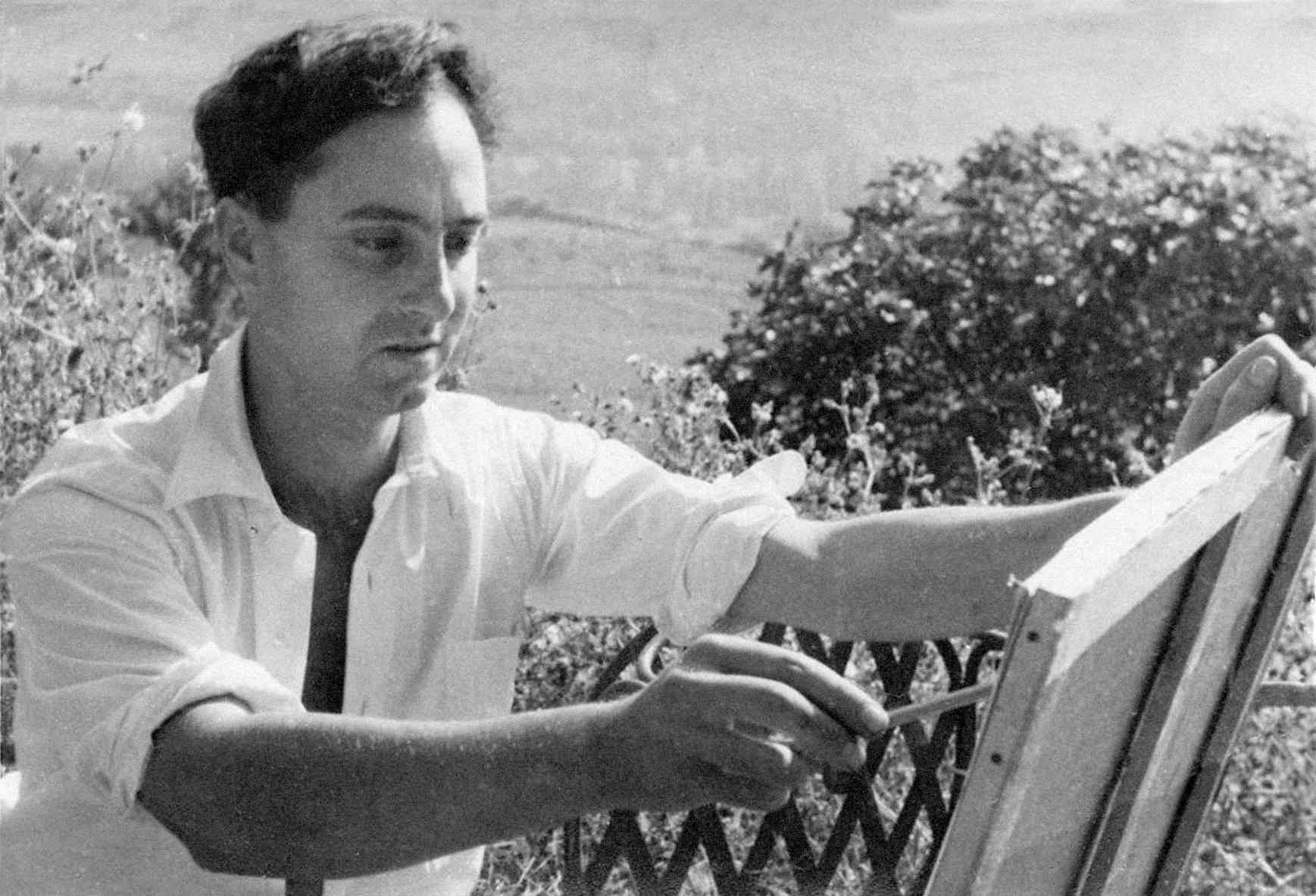 Olivier Debré, 1951. Photo DR.
Olivier Debré, 1951. Photo DR. Olivier Debré painting on the banks of the Loire river. Photo DR.
Olivier Debré painting on the banks of the Loire river. Photo DR. Olivier Debré, photo Jean-Claude Francolon
Olivier Debré, photo Jean-Claude Francolon Olivier Debré in Brouage. Photo DR
Olivier Debré in Brouage. Photo DR Olivier Debré and Serge Poliakoff, 1965 ca. Photo DR
Olivier Debré and Serge Poliakoff, 1965 ca. Photo DRPAINTINGS ON CANVAS

Olivier Debré
Composition, 1955
Oil and collage on canvas
35.5 x 46 in. / 89 x 116 cm.
Cambridge MA, Harvard Art Museums/ Fogg Museum.
Gift of Mr. G. David Thompson, in memory of his son, G. David Thompson, Jr., Class of 1958.

Olivier Debré
Untitled, c1956
Oil on canvas
57.5 x 35 in. / 146 x 89 cm.
Signed “O.DEBRE” lower right.
Private collection.
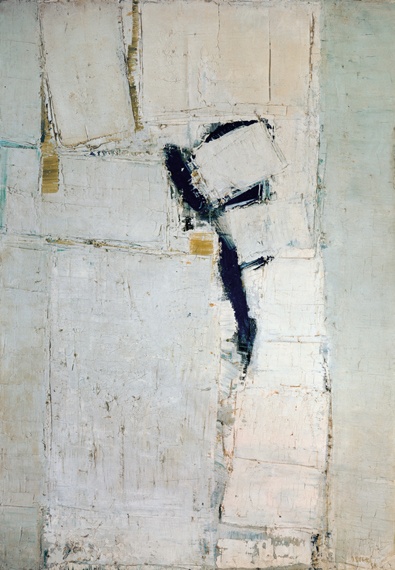
Olivier Debré
Grand personnage blanc, 1957-1958
Oil on canvas
78 x 52 in. / 195 x 130 cm.
Washington D.C., The Philips Collection

Olivier Debré
FERME PRÈS DE SAINT-GEORGES DE
DIDONNE, 1956
Oil on canvas
33.85 x 38.97 in. / 86,7 x 99,8 cm.
Signed lower right “O DEBRE”. Signed, dated and titled on reverse: “O. DEBRE sept 56 Ferme près St G. D”.
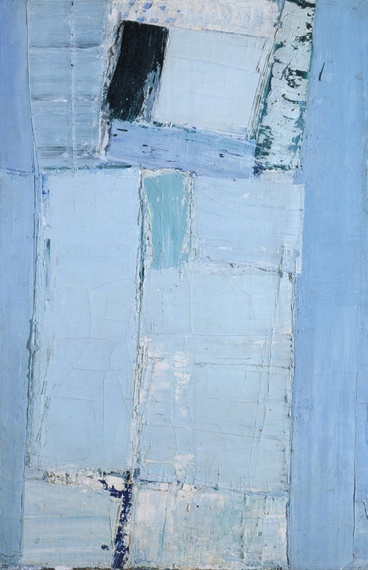
Olivier Debré
Personnage debout bleu, 1957-1958
Oil on canvas
76.8 x 50.4 in. / 195 x 128 cm.
Paris, Centre Pompidou, Musée national d’Art moderne – Centre de création industrielle. Photo Georges Meguerditchian – Centre Pompidou, MNAM-CCI / Dist.
RMN-GP.

Olivier Debré
Signe personnage gris vert, 1957
Oil on canvas
58.5 x 45.5 in. / 146 x 114 cm.
Signed and dated “O. DEBRE 57” lower right. Signed, titled and dated “O. DEBRE Signe personnage gris vert 1957” on reverse.
Private collection.

Olivier Debré
Grande ocre à la tache violette, 1970
Oil on canvas
75.59 x 76.77 in. / 192 x 195 cm.
Signed upper left on reverse “O.Debré”.
Musée d’art moderne et contemporain Saint-Étienne Métropole – Photo credits: Yves Bresson / Musée d’art moderne et contemporain de Saint-Étienne Métropole.
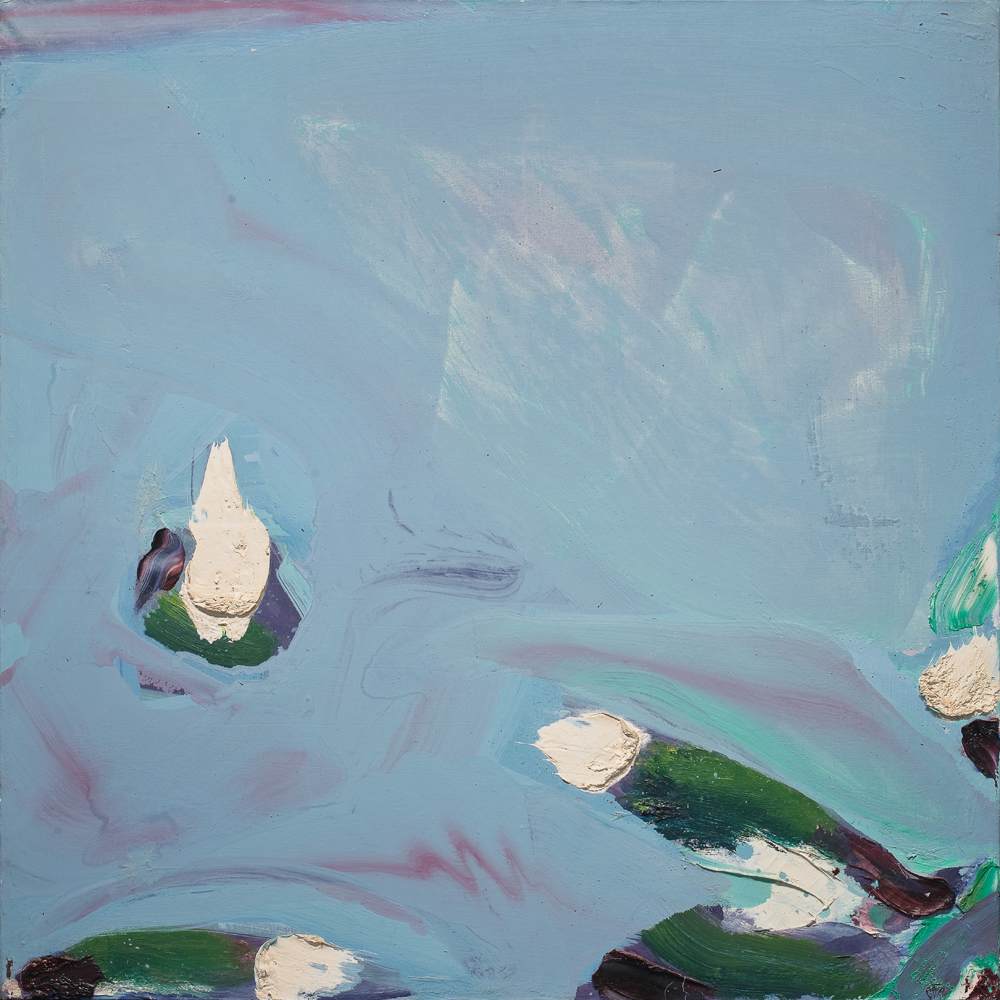
Olivier Debré
AUX TACHES BLANCHES
(SIDI BOU SAÏD), 1968
Oil on canvas
39.37 x 39.37 in. / 100 x 100 cm.
Signed lower right “OD 68”

Olivier Debré
Loire, ocre beige le soir, 1970
Oil on canvas
39.4 x 39.4 in. / 100 x 100 cm.
Paris, Musée d’Art moderne de la Ville de Paris
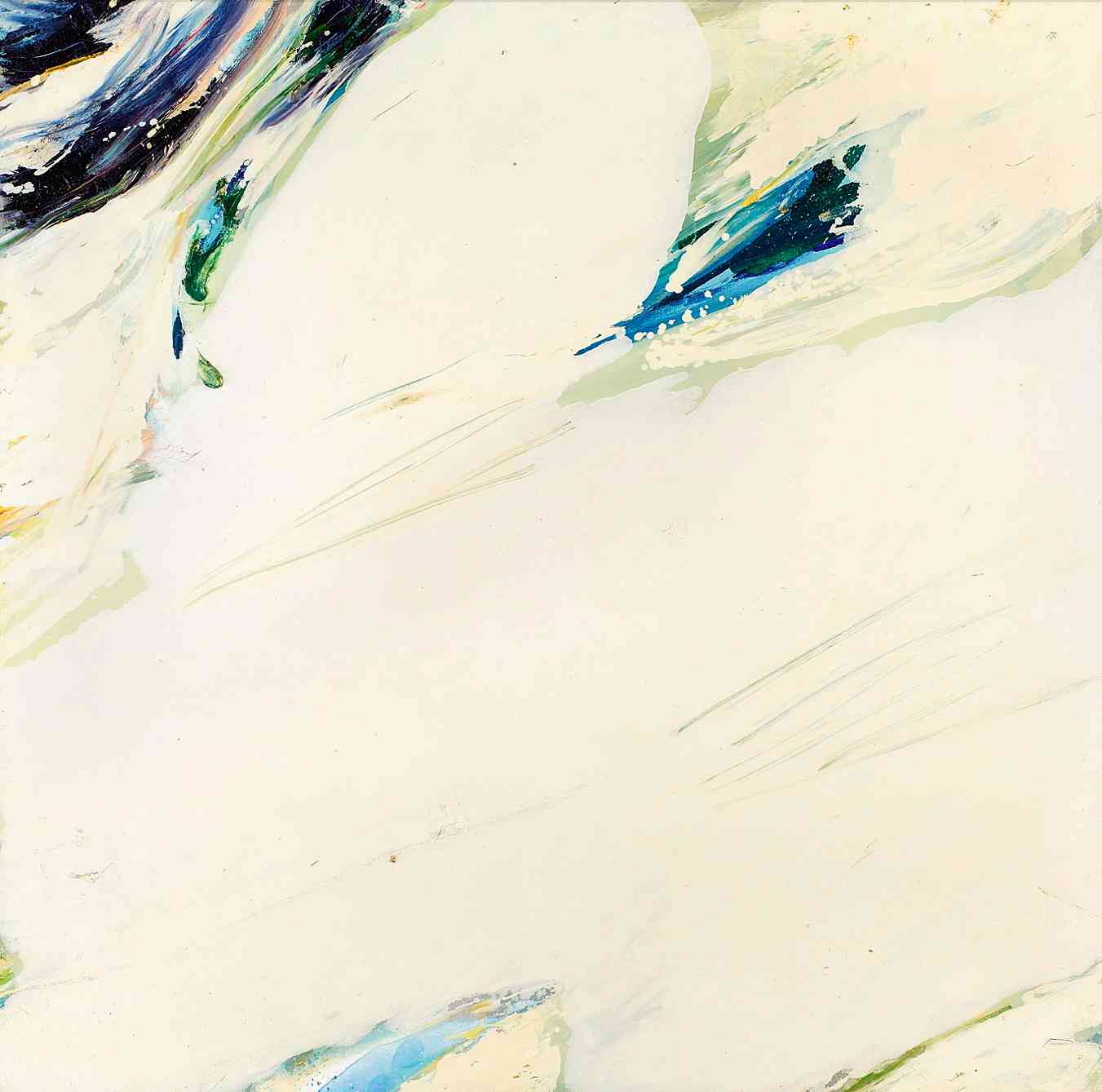
Olivier Debré
Loire, 1973
Oil on canvas
73.6 x 73.6 in. / 187 x 187 cm.
Signed, titled and dated “O. DEBRE Loire 73” on reverse.
Private collection.

Olivier Debré
Kategat gris, 1979
Oil on canvas
13 x 16.1 in. / 33 x 41 cm.
Nice, Musée d’art moderne et d’art contemporain.

Olivier Debré
Grande verte et bleue Svanoy, 1974
Oil on canvas
72.8 x 72.8 in. / 185 x 185 cm.
Signed and dated “OD 74” lower right. Signed, titled and dated “O. DEBRE grande verte et bleue Svanoy 74” on reverse.
Private collection.

Olivier Debré
Plein ocre, 1980-1982
Oil on canvas
76.4 x 76.8 in. / 194 x 195 cm.
Paris, Fond régional d’Art contemporain (FRAC) d’Ile-de-France. Photo Georges Poncet.
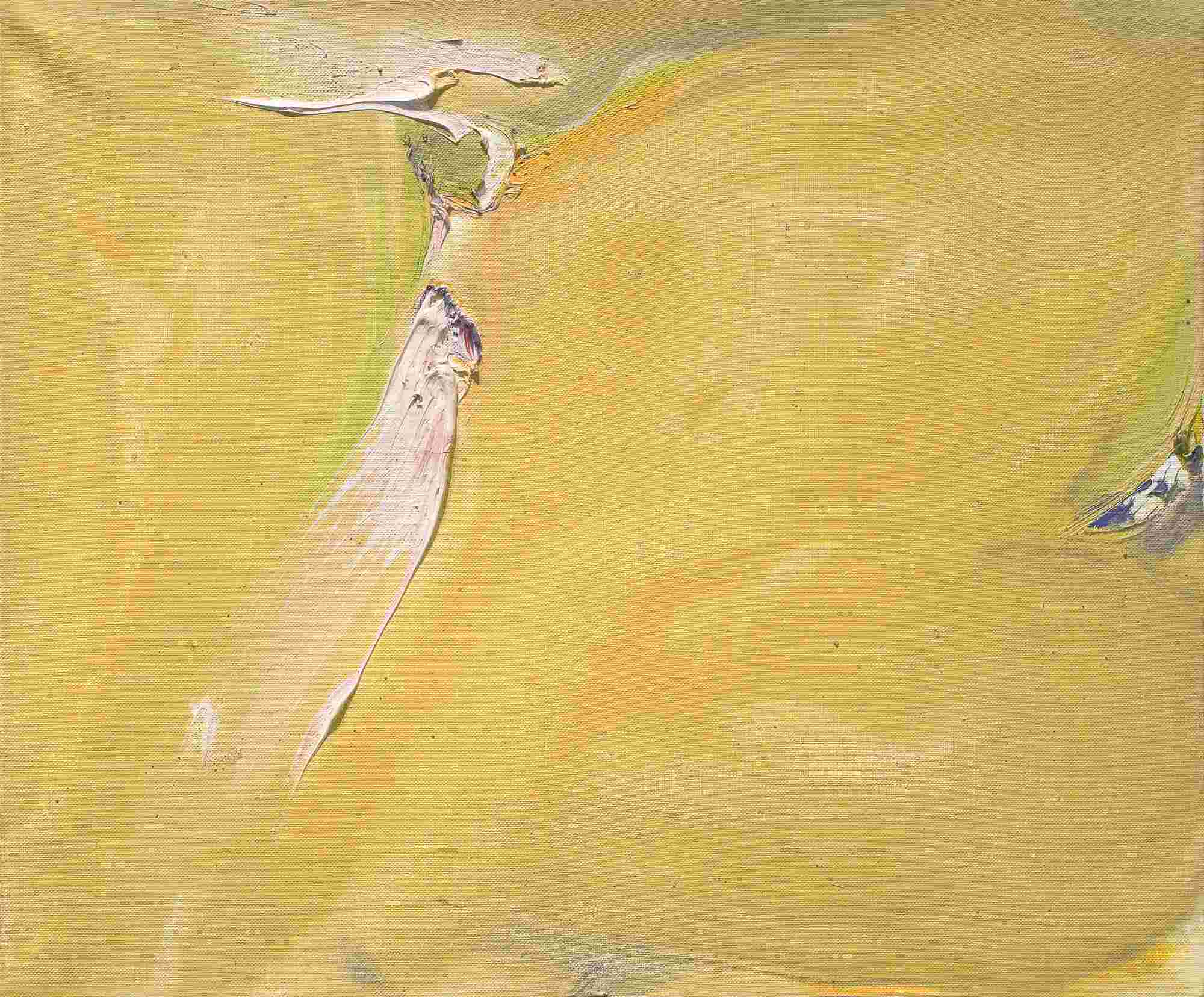
Olivier Debré
Petite ocre tache rose, 1975
Oil on canvas
14.96 x 18.11 in. / 38 x 46 cm.
Countersigned, titled, dated and dedicated “O. Debré Petite ocre tache rose oct 1975 à Gigi o 76” on reverse.

Olivier Debré
Huile bleue, 1976
Oil on canvas
196.85 x 511,81 in. / 500 x 1300 cm.
Monumental painting realised for École polytechnique-Palaiseau, main hall. © Collections École polytechnique-Palaiseau.
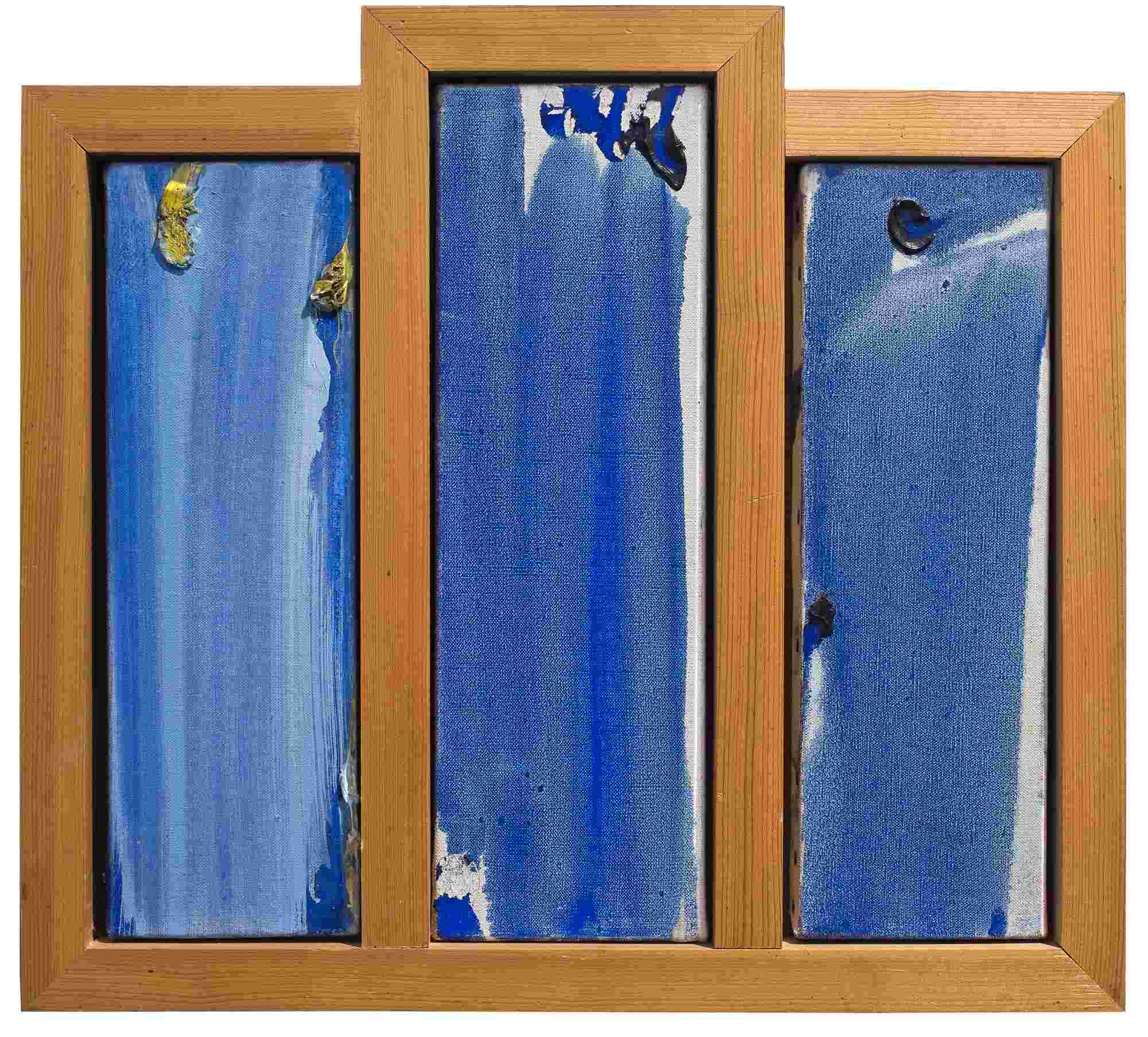
Olivier Debré
ÉTUDES POUR LA PEINTURE, NOUVELLE ÉCOLE POLYTECHNIQUE, 1976
Mixed media on canvas
13.38 x 4.33, 14.56 x 4.52 and 13.38 x 4.33 in. /
34 x 11, 37 x 11,5 and 34 x 11 cm.
3 monograms on reverse.

Olivier Debré
Suite Garonne, 1996
Oil on canvas
39.37 x 39.37 in. / 100 x 100 cm.
Coproduction of Espace d’art moderne et contemporain de Toulouse and Midi-Pyrénées for Festival Garonne 1996. Les Abattoirs FRAC Midi-Pyrénées.Photo credit: Grand Rond Production

Olivier Debr
SOURIRE DE S ROUGE, 1976
Oil on canvas
12.59 x 9.44 in. / 32,5 x 24,2 cm.
Signed, titled and dated “O.DEBRÉ Sourire De S rouge 76” on reverse.
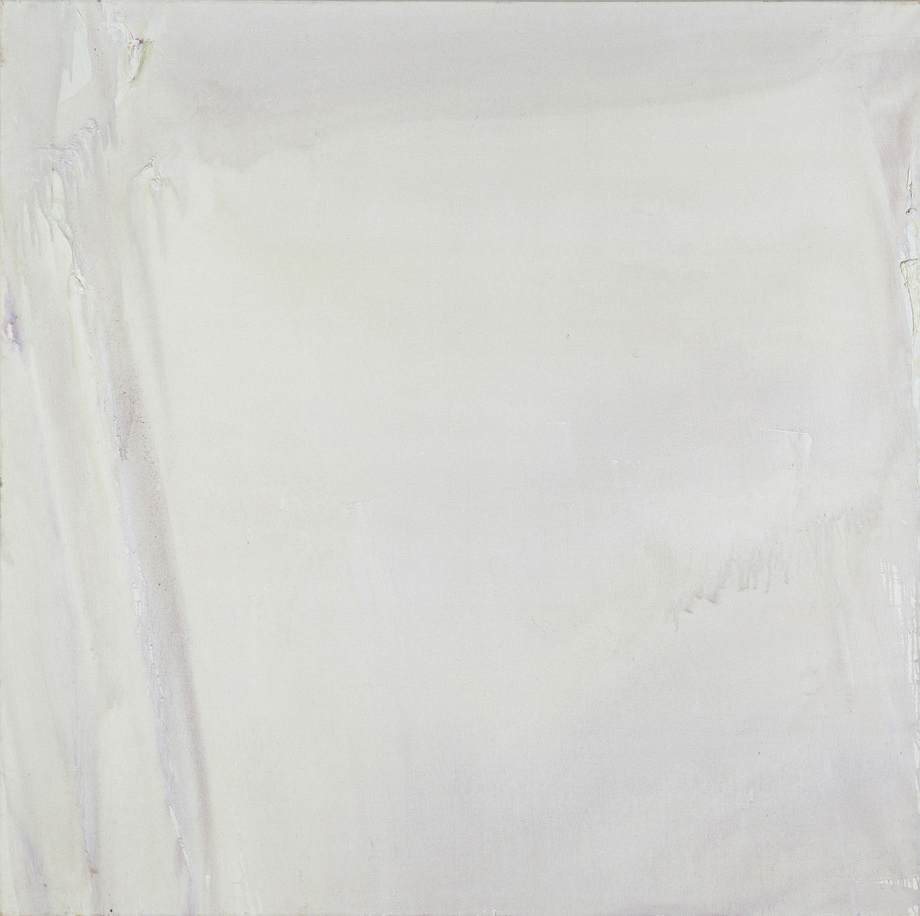
Olivier Debré
Blanche de Loire d’hiver, 1976-1977
Oil on canvas
71.65 x 71.65 in. / 182 x 182 cm.
FRAC Picardie – Des mondes dessinés.
Photo credit: André Morin.

Olivier Debré
PETITE GRISE DE SAVOIE, 1976
Oil on canvas
9.44 x 12.99 in. / 24 x 33 cm.
Signed and dated “O.DEBRÉ petite grise de Savoie 76” on reverse.

Olivier Debré
Bleu violet de soir à Þingvellir, 1996
Oil on canvas
39.4 x 39.4 in. / 100 x 100 cm.
Reykjavik, Art museum.

Olivier Debré
Faille jaune vif, fond bleu vert, 1990
Oil on canvas
70.86 x 70.86 in. / 180 x 180 cm.
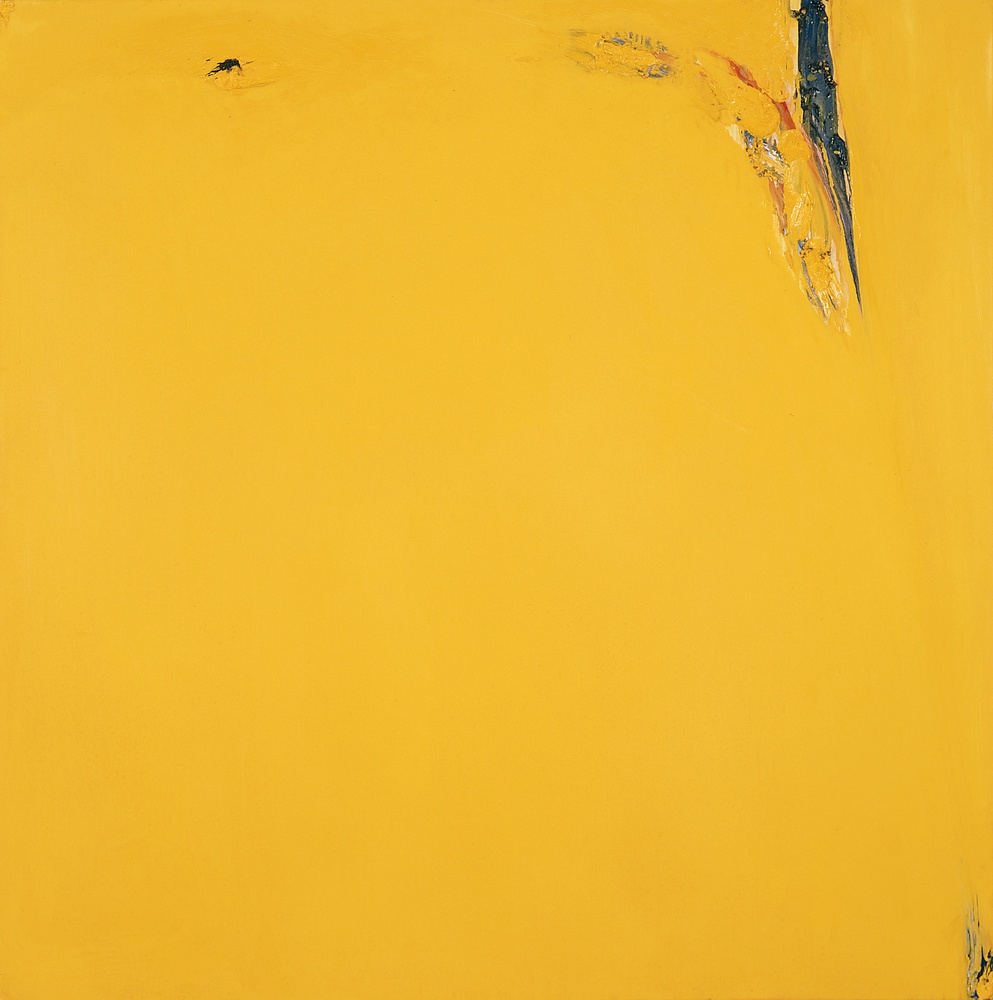
Olivier Debré
Plein jaune doré d’automne, 1989
Oil on canvas
70.07 x 70.86 in. / 178 x 180 cm.
Titled “Plein jaune doré d’automne, Touraine” on reverse.
Seine-Saint-Denis, Collection Départementale d’Art Contemporain.

Olivier Debré
Rouge – orange coulé des Hautes montagnes, Lærdal, 1990
Oil on canvas
47.24 x 59.05 in. / 120 x 150 cm.

Olivier Debré
Suite Garonne, 1996
Oil on canvas
67.55 x 109.44 in. / 171,6 x 278,2 cm.
Coproduction of Espace d’art moderne et contemporain de Toulouse and Midi-Pyrénées for Festival Garonne 1996.
Les Abattoirs, FRAC Midi-Pyrénées. Photo credit: Grand Rond Production.

Olivier Debré
BLEU DE ROYAN TACHES VIVES, 1993
Oil on canvas
23.81 x 19.68 in. / 60,5 x 50 cm.
Signed, dated and dedicated “A Suzanne B toute l’amitié O” on reverse.
MIXED MEDIA ON PAPER
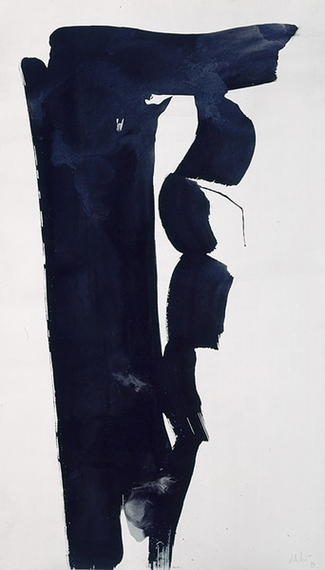
Olivier Debré
Untitled, 1985
Gouache and ink on paper
54.13 x 31.10 in. / 137,5 x 79 cm.
Nice, Musée d’Art Moderne et d’Art Contemporain.
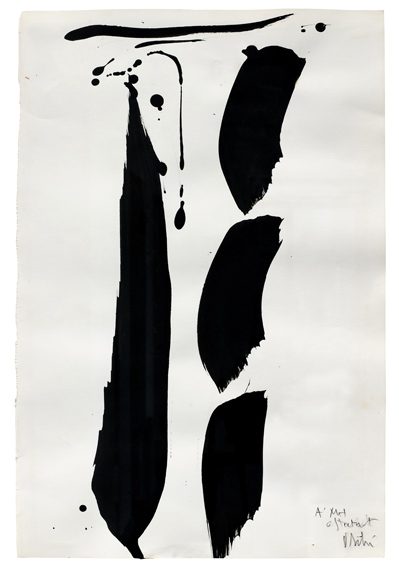
Olivier Debré
Composition, 1976
India ink
19.68 x 12.99 in. / 50 x 33 cm.
Signed and dedicated lower right “A MH affectueusement O Debré”
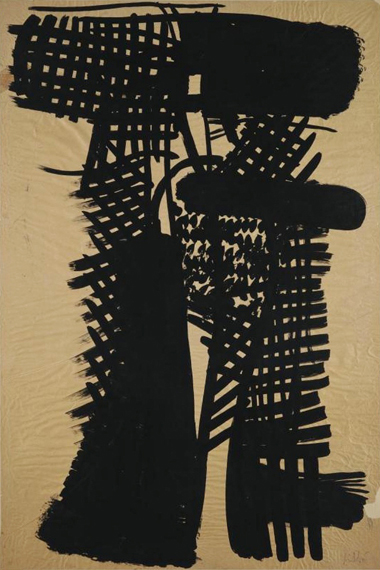
Olivier Debré
Signe personnage, 1951–1952
India ink on paper
46.85 x 31.10 in. / 119 x 79 cm.
Signed lower right “Olivier Debré”.
Photo Jacques Faujour – Centre Pompidou, MNAM-CCI / Dist. RMN-GP
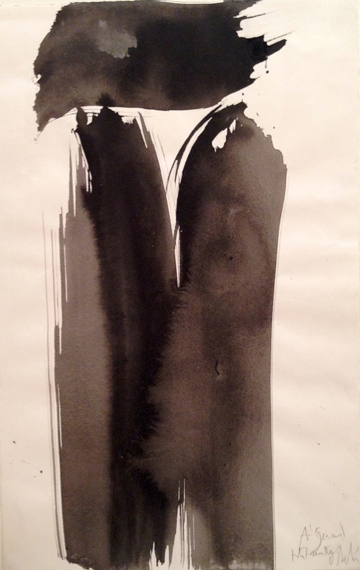
Olivier Debré
Untitled, c1980
Ink on paper
19.48 x 10.82 in. / 49,5 x 27,5 cm.
Signed and dedicated lower right “A Gérard”

Olivier Debré
Untitled, 1986
India ink on paper
71.25 x 19.29 in. / 181 x 49 cm
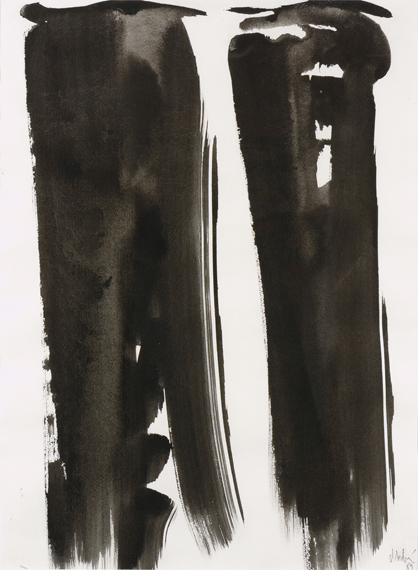
Olivier Debré
Untitled, 1989
Ink
29.92 x 22.04 in. / 76 x 56 cm.
Signed and dated lower right “O Debré 89”.
Translation of the poem “Impressions de voyage”
written by Olivier Debré for the exhibition at Galerie Ariel in Paris, in October 1973.
Impressions
of a
journey
The line I trace becomes
the path of my life
Through the narrow blackness of the
trail I pass into the universe
in search of my image.
By its presence I am
sensitive to myself and my
reality is my body.
Fervour infuses the line
It is effusion
Through it I penetrate the place
It is fusion
I taste its form
They are the senses
In it I pursue myself
It is the analysis
It is the tree I plant
This is creation,
Because it is the trunk, the column
and the stone
It is the tower and the wall
the house and the city
It is the high temple
and the vast castle
and the holy cathedral
If I palpate its texture
I become the law
that determines
If in sliding inside it, I
understand its trace
I define the Spirit
It is granite of Egypt
marble of Paros
but it is the Thought
of the Prophets
To the wonderful country of
the negation of the real, to the centre
of appearance, child of illusion,
it rolls like the echo of the Hindi
with multiple vaults: from
nature
Stone of the raked sand
of the Ryoanji, it dives into the void
to emerge in the conscience of
the other.
Sensual, it develops the
curves and the Kufics to
possess the world.
It is the law that creates and which knows
in the West
Greek, from the left where I am born
to the right where I am going, in the time
counted of the life lived, runner
of the plan stadium, it measures my
own dimension as a man, balances
beauty and raises reason
to a naked divinity
A Semite faithful to ancient
Phoenicia, it rises inside
the idea of the right which leads me
to the left where, like a phoenix, from
the spirit to which I give birth
I resurrect.
After the crossing, it is
the encounter of these blind
actions
the image is now only
the mark of its own creation
and the invisible has found
its appearance.
The sign traces the space
of the new messianism
OLIVIER DEBRÉ
Paris 1920 – Paris 1999
École Nationale Supérieure des Beaux-Arts in Paris.
(Architecture department in his uncle’s studio, Jacques Debat-Ponsan).
Professor at the École Nationale Supérieure des Beaux Arts in Paris for the mural painting from 1980. Institute member at the French Académie des Beaux-Arts from 1999.
Solo exhibitions
1949
Paris, Galerie Bing.
1956
Paris, Galerie Michel Warren.
1959
Washington, Philips Collection, “Paintings by Olivier Debré”.
New York, Knoedler Gallery, “Debré”.
1960
Paris, Galerie Charpentier.
Paris, Galerie Knoedler, “Debré. Peintures récentes”.
1962
Geneva, Musée de l’Athénée.
Lucerne, Galerie Ronca Hans.
Milan, Galleria Pagani del Grattacielo.
1963
New York, Knoedler & Co. Gallery, “O. Debré”.
Paris, Galerie Knoedler, “O. Debré. Peintures de 1960 à 1963”.
1966
Cluny, Collège culturel de Merzé.
Frankfurt, Appel und Fertsch Gallery, “Olivier Debré. Malerei».
Le Havre, Musée des Beaux-Arts, “Olivier Debré. Peintures 1943-1966”.
Oslo, Galleri Haaken.
Toulouse, Galerie de l’Atelier.
1967
Cannes, Galerie Cavalero, “Olivier Debré. Peintures”.
1968
Bordeaux, Galerie des Beaux-Arts, “O. Debré”.
Paris, Musée Galliera, “Olivier Debré, peintures – Gilioli, sculptures”.
Oslo, Galleri Haaken.
1969
Brest, Musée, “O. Debré. Œuvres de 1940 à 1969”.
Caen, Maison de la Culture, “Dix-huit peintures”.
Grenoble, Galerie Hébert.
Liège, Galerie de l’A.P.I.A.W.
1970
Avignon, Galerie Thot.
Milan, Galleria Pagani, “Olivier Debré”.
Vivoin, Centre culturel du Prieuré, “Olivier Debré. Peintures hors formats”.
Tokyo, Nippon Gallery, “Oliver Debré”.
1971
Oslo, Galleri Haaken.
1972
Geneva, Musée de l’Athénée.
Oslo, Galleri Haaken.
1973
Basel, Galerie Bettie Thommen.
Paris, Galerie Ariel.
1974
Auvernier (Switzerland), Galerie Numaga, “Olivier Debré”.
Les Sables-D’Olonne, Musée de l’Abbaye de Sainte-Croix, “Olivier Debré (dessins, sculptures, 1941-1974)”.
New Delhi, Institut français.
Paris, Galerie Ariel.
1975
Antibes, Musée Picasso.
Brussels, Galerie Montjoie.
Paris, Musée d’Art moderne de la Ville de Paris, “Olivier Debré. De la peinture au dessin”.
Saint-Étienne, Musée d’Art et d’Industrie et Maison de la Culture et des Loisirs.
Oslo, Galleri Haaken.
1976
Paris, Galerie Ariel.
Paris, Artcurial, “Debré, sculptures”.
Nantes, Musée des Beaux-Arts.
1977
Cannes, Galerie Cavalero, “Olivier Debré. Peintures”.
Cardiff, National Museum of Wales.
Cardiff, Oriel Gallery.
Saint-Étienne, Galerie Hérodiade.
1978
Aalborg (Denmark), Nordjyllands Kunstmuseum.
Copenhagen, Lyngby Kunstforening.
Tours, Galerie Jacques Davidson, “Œuvres récentes de Touraine”.
1979
Liège, Musée des Beaux-Arts.
Montbéliard, Maison de la Culture.
Oslo, Galleri Haaken.
Paris, Galerie Daniel Templon, “Olivier Debré. Œuvres récentes”
Randers (Denmark), Nord Gallery.
Rottweil (WG), Forum Kunst, “Olivier Debré. Bilder Skulpturen”.
Trondheim (Norway), Riis Galleri, “Olivier Debré. Separatutstilling Olje”.
Varberg (Sweden), Museet I Varberg.
1980
Cases-De-Pène (Perpignan), Fondation du château de Jau, “Olivier Debré”.
Poitiers, Musée Sainte-Croix.
Strasbourg, Musée d’Art moderne et contemporain.
Tours, Musée des Beaux-Arts.
1981
Dusseldorf, Hans Strelow Gallery.
Fontevraud, Abbaye de Fontevraud.
Luxembourg, Galerie Paul Bruck.
1982
Alençon, Galerie Jacques Goupil, “O. Debré. Œuvres originales, huiles et encres”.
Lyon, Galerie l’Œil Écoute.
Nantes, Galerie Convergence.
New York, Gimpel & Weitzenhoffer Gallery.
Oslo, Galleri Riis.
Toulouse, Galerie Jacques Girard.
Washington, K. Gallery
1983
Houston, Meredith Long & Company, “Oliver Debré: Abstract Works on Canvas”.
Marseille, Galerie Athanor, “Olivier Debré. Peintures”.
New York, Gimpel & Weitzenhoffer Gallery.
Randers (Denmark), Nord Gallery.
Washington, K Gallery.
1984
Bourges, Maison de la Culture, “Peinture, Peinture”.
Chicago, Galerie d’Art International.
Copenhagen, Asbaek Gallery.
Paris, Pavillon des Arts, “Oliver Debré – Grands formats 1982-1984”.
Paris, Galerie Daniel Templon, “Olivier Debré. Peintures récentes”.
Paris, Galerie Daniel Gervis.
Valence, École régionale des Beaux-Arts, “Olivier Debré. Peintures.
Lithographies. Sculptures”.
1985
Bourg-en-Bresse, Musée de Brou, “Olivier Debré. Œuvres récentes”.
Colmar, Galerie Jade, “Olivier Debré. Peintures récentes”.
Mulhouse, Galerie de la Société industrielle de Mulhouse.
Orléans, Musée des Beaux-Arts, “Olivier Debré”.
Oslo, Galleri Haaken, “Olivier Debré. Malerier”.
Sommières, Château de Poudres.
Toulouse, Galerie Jacques Girard.
1986
Brussels, Galerie La Main.
Caen, Théâtre municipal & Galerie de l’Artothèque, “Olivier Debré.
Estampes et encres de Chine”.
Dakar, Musée Dynamique, “Olivier Debré”.
Geneva, Galerie Sonia Zannettacci.
La Tronche (Grenoble), Musée Hébert, “Peintures, encres de Chine, sculptures”.
Luxembourg, Galerie du Luxembourg.
Metz, Musée d’Art et d’Histoire, “Olivier Debré, peintures de 1943 à 1986”.
Paris, Galerie Daniel Templon, “Olivier Debré. Peintures récentes”.
Paris, Galerie Leif Stahle, “Olivier Debré. Encres de Chine”.
1987
Châteauroux, Abbaye des Cordeliers, “Olivier Debré”.
Paris, Rotonde Colbert, Bibliothèque nationale, “Olivier Debré: l’œuvre gravé”.
1988
Boulogne-Billancourt, Centre culturel, “Olivier Debré. Œuvres
monumentales 1966-1988”.
Montauban, Musée Ingres, “Olivier Debré: peintures”.
Nevers, Maison de la culture de Nevers et de la Nièvre, “Notes de voyage d’Olivier Debré”.
1989
Hamburg, Keeser-Bohbot Gallery & Institut français Hamburg.
Lyon, Galerie Michel Guinle-La Main.
Paris, Galerie Daniel Gervis, “Olivier Debré. Tapis originaux”.
Paris, Galerie Daniel Templon, “Olivier Debré. Le Rideau de Hong Kong. Peintures, esquisses, travaux préparatoires”.
Paris, La Défense, Galerie La Défense Art 4.
Tours, Château de Tours, Galerie Davidson, Espace Malraux et Centre culturel de Joué.
1990
Baden-Baden, Frank Pages Art Gallery, “Olivier Debré. Œuvres récentes 1985-1990”.
Carcassonne, Musée des Beaux-Arts, “Olivier Debré. Œuvres récentes 1988-1989-1990”.
Laon, Maison des Arts et Loisirs.
La Seyne-sur-Mer, Fort Napoléon, “L’Opéra de la vie: Olivier Debré”.
Paris, Artcurial, “Olivier Debré. Lithographies et gravures 1945-1990”.
Paris, Fondation Louis-Vuitton pour l’Opéra et la Musique, Musicora, Grand Palais (Models for the stage curtain of the Hong Kong Opera).
Oslo, Galleri Haaken, “Olivier Debré. Malerier fra Numedal og Lærdal 1988 og 1989”.
Saint-Denis, Musée d’Art et d’Histoire, “Debré. Dessins 1945-1960”.
1991
Tours, Centre de Création Contemporaine, “Olivier Debré, quatre tableaux”.
Amboise, Château.
Toulouse, Artothèque.
Edinburgh, Institut français.
London, Institut français.
Villeneuve-Tolosane, Le Majorat, “Olivier Debré. Estampes”.
Luxembourg, Galerie du Luxembourg, “Peintures et encres de Chine, 1985-1990”.
Oslo, Galleri Haaken.
Tokyo, Yoshii Gallery.
Laval, Musée de Laval.
La Roche-sur-Yon, Hôtel du département.
Angers, Maison de la Culture / Nouveau Théâtre.
Rodez, Musée Denys-Puech, “Olivier Debré. Œuvres de 1948 à 1990”.
1992
Saint-Étienne, Galerie L’.
1993
“Olivier Debré. Rétrospective 1943-1993”, exhibition organised in three parts:
– Montbéliard, Musées, Château des ducs de Wurtemberg, “Les signes-personnages, la verticalité”
– Valence, Musée, “Les signes-paysages, l’espace”
– Ajaccio, Musée Fesch, “Les carnets de voyages, la couleur”.
Montigny-le-Bretonneux, Théâtre de Saint-Quentin-en-Yvelines, exhibition in three parts renewal “Olivier Debré. Rétrospective 1943-1993“ with the “Architecture” part.
Paris, Galerie Jeanne Bucher, “Olivier Debré. Anatomie du sourire.
Eaux-fortes et textes originaux”.
Paris, Musée de la Poste, “Olivier Debré. 50 tableaux pour un timbre”.
1994
Paris, Galerie Gérald Piltzer, “France-Amérique: Olivier Debré-Jules Olitski”.
Oslo, Galleri Haaken, “Olivier Debré paysages de la vallée de Lædal, Norvège, 1993”.
Ossiach, Galerie Carinthia, “Olivier Debré”.
Valencia, Galeria Charpa.
1995
Luxembourg, Galerie du Luxembourg, “Olivier Debré: dessins estampes”.
Paris, Galerie nationale du Jeu de Paume, “Olivier Debré. Rétrospective”.
Aix-en-Provence, Galerie de la Prévôté, “Signes” (exhibition organised for the Festival d’Art et de Musique).
Compiègne, Espace Jean Legendre, “Olivier Debré. Un peintre dans la ville”.
1996
Lienz (Austria), Städtische Gallery.
Klagenfurt, Carinthia Gallery, “Olivier Debré. Bilder – Graphiken”.
Liège, Musée Saint-Georges, “Olivier Debré. Rétrospective”.
Milan, Galleria Credito Valtellinese, refettorio delle Stelline, “Olivier Debré. Rétrospective”.
Rome, Galleria Francese, “Olivier Debré. Carnets de voyage”.
Rosendal (Norway), Baroniet Rosendal, “Olivier Debré. Maleri”.
Stravanger, Rogaland kunstmuseum, “Olivier Debré. Rétrospective”.
Tarbes, Centre culturel, ancien Carmel, “Olivier Debré”.
Toulouse, Festival Garonne.
Chatou, Île des Impressionnistes, “Olivier Debré. 50 ans d’estampes”.
Travelling exhibition in Ukraine, in Latvia, in Vietnam, in Thailand and in Singapore.
Reykjavik, Art Museum, “Olivier Debré. Rétrospective”.
1997
Saint-Étienne-Du-Rouvray, Centre Jean-Prévost; Centre Georges Déziré & Rive Gauche, “Olivier Debré. Gravures. Lithographies”.
Medellín (Colombia), Museo de Arte Moderno de Medellín, “Olivier Debré. Rétrospective”.
Mexico, Museo del Palacio de Bellas Artes, “Olivier Debré. Rétrospective”.
Rio De Janeiro, Museu de Arte Moderna do Rio de Janeiro, “Olivier Debré. Rétrospective”.
Washington D.C., Alex Gallery, “Olivier Debré. Paintings and Prints, 1948-1996”.
Montpellier, Château d’O, “Olivier Debré”.
1998
Paris, Galerie La Hune-Brenner.
Oslo, Astrup Fearnley Museet, “Olivier Debré en Norvège”.
Kamakura (Japan), Museum of Modern Art, “Olivier Debré. Rétrospective”.
Beijing, Beijing Museum of Natural History, “Olivier Debré. Rétrospective”.
Hong-Kong, Museum of Modern Art, “Olivier Debré. Rétrospective”.
Tai Pei, Taipei Fine Arts Museum, “Olivier Debré. Rétrospective”.
1999
Ettlingen, Museum Ettlingen, “Olivier Debré. Rétrospective”.
Coblence, Ludwig Museum, “Olivier Debré. Rétrospective”.
Baden-Baden, Galerie Frank Pagès, “Les dix dernières années”.
Béziers, Espace Riquet, “Olivier Debré”.
2000
Royan, Centre d’Arts plastiques, “Olivier Debré, peintures de 1963 à 1999”.
Paris, École nationale supérieure des Beaux-Arts, “Hommage à Olivier Debré”.
Paris, Maison de la Chine, “Olivier Debré à Shanghai”.
2001
Angers, Musée Pincé, “Olivier Debré. Couleurs de paysages”.
Paris, Maison d’édition “Caractères” (lithographs and India inks).
2002
Monterrey (Mexico), Galeria de la Alianza Francesa, “Olivier Debré. Rétrospective”.
Élancourt, Galerie de la Ferme du Mousseaux, “Olivier Debré. Sourires de voyages”.
Bruxelles, Galerie J. Bastien Art, “Olivier Debré, 1920-1999”.
Mexico, Casa de Francia, “Olivier Debré”.
2003
Paris, Galerie Louis Carré & Cie, “Olivier Debré. Peintures”.
Paris, Galerie Yoshi, “Hommage à Olivier Debré”.
Paris, Centre Georges-Pompidou, “Olivier Debré. Œuvres de la dation”.
2004
Paris, 8ème Pavillon des Antiquaires et des Beaux-Arts, Galerie Louis Carré & Cie (India inks and sculptures).
Charleville-Mézières, Musée de l’Ardenne, “Olivier Debré. Peinture”.
Organised by the Office Régional Culturel de Champagne-Ardenne for the exhibition, “Champs libres. Le Paysage”.
Sigean, L.A.C., “Olivier Debré”.
2005
Brussels, Galerie J. Bastien Art, “Portraits de Sylvie”.
Paris, Fiac Porte de Versailles, Galerie Louis Carré & Cie, “Tous les matins du monde”.
2006
Geneva, Galerie Sonia Zannettacci, “Couleurs du monde”.
2007
Montpellier, Galerie Hélène Trintignan, “Olivier Debré”.
Angers, Musée des Beaux-Arts, “Olivier Debré. Grands formats”.
Cahors, Musée de Cahors Henri-Martin, “Olivier Debré. Parcours 1943-1998”.
Saint-Cirq-Lapopie, Musée départemental Rignault, “Olivier Debré. Signes-personnages”.
Millau, Musée de Millau et des Grands Causses, “Olivier Debré. Voyages”.
Roanne, Musée des Beaux-Arts et d’Archéologie J. Déchelette, “Olivier Debré. Loire… paysages abstraits”.
2008
Orléans, Musée des Beaux-Arts, “Olivier Debré. Paysages de Loire”.
Pont-Aven, Musée des Beaux-Arts, “La poétique de l’eau”.
Brussels, Galerie J. Bastien Art, “Génie nomade”.
Chenonceaux, Château de Chenonceau, “Olivier Debré, peintre voyageur de la Touraine au monde”.
2009
Dunkirk, LAAC – Lieu d’Art et Action contemporaine, “Olivier Debré, Signes-personnages”.
Mantes-La-Jolie, Musée de l’Hôtel-Dieu, “Olivier Debré, de Loire et d’ailleurs”.
Paris, Galerie Louis Carré & Cie, “Olivier Debré. Formes informelles”.
Saint-Louis, Espace d’Art contemporain Fernet-Branca, “Olivier Debré, signes-paysages / grands formats”.
2010
Vannes, Musée de la Cohue, “Olivier Debré. Signes paysages, signes gravés”.
Algiers, MAMA – Musée national d’Art moderne et contemporain, “Olivier Debré”.
Paris, Galerie Arlette Gimaray, “Olivier Debré. Encres de Chine des années 1980 et 1990”.
Martigues, Musée Ziem, “Signes-paysages”.
2011
Brussels, Musée d’Ixelles, “Olivier Debré. Un abstrait lyrique. Rétrospective”.
Paris, Galerie Louis Carré & Cie, “Olivier Debré. Les années cinquante”.
2013
Paris, Galerie Brame & Lorenceau, “Olivier Debré. Les années 1950-1960”.
Paris, Galerie Louis Carré & Cie, “Olivier Debré, peintures noires”.
Carcassonne, Musée des Beaux-Arts, “Olivier Debré, signes personnages, signes-paysages”.
2014
Paris, Galerie Diane de Polignac, “Olivier Debré”.
2017
Paris, Galerie Diane de Polignac & Chazournes, “Olivier Debré”.
Selected group exhibitions
1948
Paris, Parc des Expositions, XVème Salon des Surindépendants.
1949
Paris, Musée des Beaux-Arts de la Ville de Paris, Salon d’automne.
Paris, Beaux-Arts de la Ville de Paris, XVIème Salon des Surindépendants.
1950
New York, Perspectives Gallery.
Paris, Salon de mai.
Paris, Grand Palais, Salon d’automne.
1951
Paris, Galerie La Hune.
1952
Paris, Salle André-Baugé, 1er Salon d’octobre.
Paris, Grand Palais, Salon d’automne.
1953
Paris, Palais de New York, IXème Salon de mai.
Paris, Studio Paul Facchetti, “Debré, Laubiès, Downing…”
Paris, Galerie Craven, IIème Salon d’octobre.
1954
Paris, Salon Comparaisons.
Paris, Musée municipal d’Art moderne, Xème Salon de mai.
1955
Paris, Studio Paul Facchetti.
Rouen, Musée des Beaux-Arts, “Art 1955”.
Lissone (Milan), IXème Premio Lissone Internazionale per la Pittura.
1956
Paris, Musée d’Art moderne de la Ville de Paris, XIIème Salon de mai.
1957
Paris, Musée d’Art moderne de la Ville de Paris, Salon Comparaisons.
Paris, Galerie Creuze, “Cinquante ans de peinture abstraite”.
Paris, Galerie Michel Warren, “Debré et Germain”.
Paris, Musée d’Art moderne de la Ville de Paris, XIIème Salon des réalités nouvelles.
1958
Paris, Musée d’Art moderne de la Ville de Paris, XIVème Salon de mai.
Paris, Musée d’Art moderne de la Ville de Paris, XIIIème Salon des réalités nouvelles.
1959
Turin, Palazzo delle Arti, Vème Mostra, “Pittori d’Oggi”.
Liverpool, Walker Art Gallery, “The John Moores Liverpool Exhibition 2”.
Lissone (Milan), XIème Premio Lissone Internazionale per la Pittura.
1960
Paris, Musée d’Art moderne de la Ville de Paris, XVème Salon des réalités nouvelles.
Paris, Musée d’Art moderne de la Ville de Paris, XVIème Salon de mai.
Paris, Galerie Charpentier, “École de Paris, 1960”.
Paris, Galerie de Seine.
Turin, Galleria La Bussola.
Brussels, Palais des Beaux-Arts, “Prix Marzotto”.
1961
Paris, Musée d’Art moderne de la Ville de Paris, XVIIème Salon de mai.
Paris, Galerie Jacques Massol, “Expo. 36 dessins contemporains”.
Paris, Musée d’Art moderne de la Ville de Paris, XVIème Salon des réalités nouvelles.
1962
Paris, Musée d’Art moderne de la Ville de Paris, Salon Comparaisons.
Paris, Musée d’Art moderne de la Ville de Paris, XVIIème Salon des réalités nouvelles.
Paris, Grand Palais, Salon Grands et Jeunes d’aujourd’hui.
Paris, Musée des Arts décoratifs, “Antagonismes 2 – L’objet”.
1963
Paris, Musée d’Art moderne de la Ville de Paris, XVIIIème Salon des réalités nouvelles.
Paris, Galerie internationale d’Art contemporain; Recklinghausen; Lubeck; Basel; Frankurt; “Actualité et Tradition du tapis”.
Paris, Grand Palais, Salon d’art contemporain.
Paris, Galerie Denise René, “Esquisse d’un salon”.
Nice, Palais de la Méditerranée, “Comparaisons. Sélection 63”.
1964
Menton, Maison de la Culture, Vème Biennale de peinture.
Antibes, Bastion Saint-André, “De la forme à l’infiguré”, for the second Festival des Arts plastiques de la Côte d’Azur.
Cannes, Galerie Cavalero, “Les voies de la figuration actuelle”, for the second Festival des Arts plastiques de la Côte d’Azur.
Paris, Musée d’Art moderne de la Ville de Paris, XXème Salon de mai.
Paris, Galerie Synthèse, “Lauréats de la Biennale de Menton”.
Namur, Maison de la Culture, XIXème Salon des réalités nouvelles.
Toulouse, Galerie l’Atelier, “Pour une nouvelle conception du paysage”.
1965
Paris, Musée d’Art moderne de la Ville de Paris, XXème Salon des réalités nouvelles.
Paris, Musée d’Art moderne de la Ville de Paris, XXIème Salon de mai. Travelling exhibition of French art in Latin America: Rio De Janeiro; Buenos Aires; Montevideo; Santiago; Lima; La Paz; Bogota; Caracas.
Paris, Musée Galliera, “Promesses tenues”.
Helsinki, Ateneum; Tampere, Museum of Modern Art; Turku, Museum of Modern Art, “Peinture contemporaine en France”.
Travelling exhibition of French art in Western Europe: Prague; Brno (Czechoslovakia); Bucarest; Budapest; Lassy (Hungary).
Paris, Salon d’automne.
Paris, Salon Grands et Jeunes d’aujourd’hui.
Paris, Galerie Claude Bernard, “Sculptures de peintres”.
Paris, Galerie Beno d’Incelli.
1966
Charleroi, Palais des Beaux-Arts.
Namur, Maison de la Culture, “Tapis français contemporains” (Travelling exhibition organised by Galerie Denise Majorel, Paris).
Paris, Musée d’Art moderne de la Ville de Paris, XXIIème Salon de mai.
Lausanne, Musée Cantonal des Beaux-Arts, “IIème Salon international des Galeries-pilotes; artistes et découvreurs de notre temps”.
Paris, Musée d’Art moderne de la Ville de Paris, XXIème Salon des réalités nouvelles.
Grenoble, Musée de Peinture et de Sculpture, “Climat 66”.
Paris, Galerie Cimaise-Bonaparte, “Petits formats”.
Paris, Galerie Zuzini, “Le naturalisme imaginaire abstrait”.
1967
Paris, Galerie Cimaise-Bonaparte, “Les quatre éléments”.
Paris, Musée d’Art moderne de la Ville de Paris, XXIIème Salon des réalités nouvelles.
Schiedam, Stedelijk Museum, “Huit peintres de Paris”.
Paris, Musée d’Art moderne de la Ville de Paris, XXIIIème Salon de mai.
Paris, Musée Galliera, “L’âge du jazz”.
Saint-Paul-De-Vence, Fondation Maeght, “Dix ans d’art vivant (55-65)”.
Paris, Galerie Vercamer, “Permanence de la peinture”.
Jouy-en-Josas, Cimaise HEC, “Vingt peintres du XXème siècle”.
Céret, Musée d’Art moderne, “Peinture ininterrompue I”.
Paris, Musée Galliera; Nantes; Brest; Orléans, Musée; Le Creusot, Maison de la Culture; Lorient, Maison de la Culture; Reims, Maison de la Culture, “Une aventure de l’art abstrait”.
Berlin, “Tendances de la peinture française contemporaine”.
Tokyo, Nippon Gallery, “Quinze artistes français”.
Kendal; Boltonb; Middlesbrough; Sunderland, “XXth Century European Paintings”.
Müscarnok; Prague, “Rajzes Akwarell Franciaor Szàgban – Matisse tôl Napjainkig”.
Montréal, Pavillon de la Communauté européenne, “L’art moderne en Europe, Expo 67”.
1968
Paris, Musée d’Art moderne de la Ville de Paris, IXème Salon Grands et Jeunes d’aujourd’hui.
Paris, Galerie Max Kaganovitch, “D’après le paysage”.
Paris, Musée d’Art moderne de la Ville de Paris, XXIVème Salon de mai.
Belgrade, “Savremeno francusko slikarstvo”.
Saint-Jean-de-Monts, Palais des Congrès, “Triade 68”.
Cachan, Hôtel de Ville, IIème Biennale des artistes de Cachan et de l’Île-de-France.
Grenoble, Maison de la Culture, inaugural exhibition.
Paris, Galerie La Demeure.
1969
Paris, Galerie Daniel Templon, “Interférences”.
Toulouse, Musée des Augustins, “Vingt ans d’acquisitions 1948-1968”.
Asnières, Salon.
Prague; Bratislava; Brno, “L’École de Paris aujourd’hui”.
1970
Osaka,”Exposition internationale, Expo 70”.
1971
Bourges, Maison de la Culture, “Sept peintures à Bourges”.
Paris, Galerie ]acob, “Les cinq ans de la Galerie Jacob”.
Marly-le-Roi, Musée national d’Éducation populaire, “Nature et source de l’homme”.
Montrouge, Biennale de Montrouge.
1972
Mâcon, Galerie des Ursulines.
Paris, Galerie Daniel Gervis.
1977
Paris, Galerie NRA, Exposition inaugurale.
Marseille, Musée Cantini, “Certitude de l’incertain”.
1978
Paris, Galerie Daniel Gervis, “L’éloge du dessin. Encres de Chine et fusains”.
Grenoble, Maison de la Culture, “L’espace du temps. Abstraction des années cinquante en France”.
1979
Frankfurt, Appel und Fertsch Gallery, “20 Jahre”.
Saint-Germain-en-Laye, “Célébration du bleu”.
Lisbon, Calouste Gulbenkian Foundation.
1981
Amman (Jordania), The Jordan Museum, “Art contemporain en France, 1960-1980”.
1982
Dallas (Texas), Delahunty Gallery.
Buffalo, Allbright Knox Art Gallery; Houston, The Rice University (The Institute of Arts); Houston, De Menil Foundation, “Twelve Contemporary French Artists” (travelling exhibition 1982-1983).
Lyon, ELAC, “Vingt ans de la Galerie L’œil écoute”.
Aubagne, Centre culturel, “Abstraction lyrique”.
Bourbon-Lancy, Musée de Saint-Nazaire, “Saint-Nazaire 1982”
1984
Venice, Sagredo Palazzo, Venice Biennale, “Peinture en France”.
1987
Strasbourg, Cloître Saint-Pierre-le-Jeune, “Silence un”.
1988
Angers, Nouveau Théâtre; Laval, Musée, Chapelle Saint-Julien; Évry, Aire libre-art contemporain Agora.
Le Mans, Musée, Collégiale Saint-Pierre-la-Cour.
Cholet, Hôtel de Ville; Saint-Jean-De-Monts, Palais des Congrès, “Abstractions lyriques : Paris 1945-1955”.
1989
Paris, La Défense, Galerie La Défense Art 4, “Olivier Debré, Patrice Giorda, Jean Le Gac”.
Créteil, Hôtel du département, “FDAC Val de Marne : acquisitions 1988”.
Fréjus, Musée Temporaire, “Fondation Daniel Templon : exposition inaugurale”.
Paris, Pavillon des Arts, “Saint-Germain-des-Prés 1945-1950”.
1990
Labège, Centre régional d’Art contemporain Midi-Pyrénées, “Les peintres et les livres”.
Mont-De-Marsan, Centre d’Art contemporain, “Olivier Debré et José Subira-Puig”.
Morlaix, Musée des Jacobins, “Jean Grenier : regard sur la peinture 1944-1971”.
Geneva, Galerie Sonia Zannettacci, “10 : Roland Topor, Abram Topor, Aeschbacher, Debré, Erro, Monory, Stämpfli, Alechinsky, Helg, Valdes”.
1991
Paris, Grand Palais, XLVIème Salon de mai.
Oslo, Galleri Haaken, “Galleri Haaken 30 âr”.
1992
Oslo, Galleri Haaken, “13 Kunstnere i Galleri Haaken”.
Le Blanc, Espace Art Brenne, “Paysage en exergue : dix années d’enrichissement du Fonds régional d’art contemporain”.
Strasbourg, Direction régionale des Douanes, “Libres espaces”.
Toulouse, Centre culturel de l’Aérospatiale, “Quinze artistes.
Quinze stations”.
1993
Fécamp, Palais Bénédictine, “En 50 figures de l’abstrait : les grands courants de l’art contemporain”.
Saint-Étienne, Musée d’Art moderne, “Entre la sérénité et l’inquiétude”.
1994
Oslo, Galleri Haaken, “Hommage à Haaken”.
1996
Tokyo, The National Museum of Modern Art; Kyoto, The National Museum of Modern Art, “La dimension du corps 1920-1980”.
Paris, Espace Cardin, “Salon coup de cœur. 40 amateurs collectionneurs présentent 80 artistes”.
1997
Versailles, Domaine de Madame Élisabeth; Archives room, “Première Biennale de la gravure d’Île-de-France”.
Paris, Galerie Denise René, “Ont-ils du métier? Propositions pour l’art vivant”.
1998
Luxembourg, Banque et Caisse d’Épargne de l’État, Galerie d’art contemporain Am Tunnel, “Artists in situ”.
Paris, Salon de mai.
Ossiach (Austria), Carinthia Gallery, “Kunst und Demokratie Widerstand und Freiheit”.
La Côte-Saint-André, Galerie Évelyne Guichard, “Nic Joosen, sculptures. Olivier Debré, œuvres sur papier et livres”.
Aix-en-Provence, Galerie d’art du Conseil général, “Autour de Georges Duby”.
Paris, XIIIème arrondissement town hall, “70ème exposition du cercle municipal des Gobelins et des Beaux-Arts”.
1999
Montréal, Galerie Simon Blais, “Julius Baltazar, Frédéric Benrath, Jean Cortot, Olivier Debré, Pierre Dmitrienko, Roseline Granet, René Làubiès, Alfred Manessier, André Marfaing, Jaroslav Serpan, Raoul Ubac, Zao Wou-Ki”.
Saché, Galerie d’art contemporain de Bécheron, “Olivier Debré et Richard Texier”.
Klagenfurt, Carinthia Gallery.
Paris, Espace Eiffel-Branly, Salon des Grands et Jeunes d’aujourd’hui (Tribute to Olivier Debré).
Paris, Galerie d’art de l’Assemblée nationale “30 artistes 1969-1999. Hommage à Olivier Debré”.
2000
Gien, Château, Musée international de la Chasse, “Olivier Debré, la Loire… et ses amis”.
2001
Aulnay-sous-Bois, Exhibition gallery Town Hall, “L’Estampe.
Le paysage, de Charles-François Daubigny à nos jours”.
Paris, Centre national d’art et de culture Georges- Pompidou, Galerie d’art graphique, “Signes, traces, écritures de Alechinsky à Zao Wou-Ki”.
Paris, Galerie Ariel, “Hommage à six peintres de la Galerie”.
Arles, Fondation Vincent-Van-Gogh, “L’iris en fleur”.
2002
Bourg-en-Bresse, Monastère royal de Brou, “Collection d’hiver, art contemporain”.
Sèvres, Manufactures nationales, Créations contemporaines.
Ginals, Abbaye de Beaulieu, Centre d’Art contemporain, “La Nouvelle École de Paris 1941-1965”.
Paris, Galerie Ariel, “50 ans de la Galerie Ariel”.
Oslo, Galleri Haaken, “Philippe Cognée, Olivier Debré”.
Paris, Galerie Ariel, “Œuvres sur papier”.
2004
Cajarc, Maison des Arts Georges et Claude Pompidou, “Lieu(x) d’être-collection les Abattoirs” (for the 30th anniversary of Georges Pompidou’s death).
Rueil-Malmaison, Atelier Grognard Rond-Point des arts, “Regard sur l’art contemporain”.
2005
Geneva, Artrium, “Olivier Debré, Antoine Poncet”.
Cahors, Musée de Cahors Henri-Martin, “50 ans de peinture en France, une galerie, une collection”.
2006
Paris, Musée du Luxembourg, “L’envolée lyrique. Paris 1945-1956”.
2007
Villeneuve-sur-Lot, Musée de Gajac, “L’action pensive”
Issy-les-Moulineaux, Johnson & Johnson, “Couleurs, Couleurs”.
Le Havre, Musée Malraux, “Gestes, signes, traces, espaces”.
Toulouse, Musée d’Art moderne et contemporain Les Abattoirs, “Hommage à André Marfaing”.
2008
Saint-Restitut, Centre d’Art contemporain, Maison de la Cure, “Une grosse caisse dans un orchestre symphonique. Patrimoine et création”.
Lyon, Musée des Beaux-Arts, “Repartir à zéro”.
2009
Paris, Galerie Guillaume, “Autour de Pierre Cabanne”.
Bellinzona (Switzerland), Museo Villa dei Cedri, “Arte & Natura”.
Montpellier, Musée Fabre, “Abstractions (1956-2006)”.
Paris, Espace Fondation EDF, “La peinture de paysage. Chemins d’une collection” (exhibition organised by Les Amis du Paysage français Association).
Luxembourg, Galerie Bernard Ceysson, “Olivier Debré/Etienne Hajdu”.
Lyon, Musée des Beaux-Arts, “Picasso, Matisse, Dubuffet, Bacon… Les Modernes s’exposent”.
2010
Aix-en-Provence, Galerie d’art du Conseil général, “L’Enfance de l’art”.
Vannes, Galerie Doyen, “100 ans de peinture en Bretagne (1880-1980) & la Loire par Olivier Debré”.
2011
Bellinzona (Switzerland), Museo Villa dei Cedri, “Parole & Figure”.
Geneva, Musée Rath, “Les sujets de l’abstraction. 101 Chefs-d’œuvre de la Fondation Gandur pour l’Art”. Kalmar (Sweden), Kalmar Castle, “Kings of Art”.
Carcassonne, Musée des Beaux-Arts, “Regard sur l’abstraction lyrique, Montparnasse et Saint-Germain-des-Prés”.
Montpelllier, Musée Fabre, “Les sujets de l’abstraction. 101 Chefs-d’œuvre de la Fondation Gandur pour l’Art”.
2012
Paris, Art Paris, Jeane Bastien booth.
Trélazé, Anciennes Écuries des Ardoisières “Montparnasse/Saint Germain-des-Prés, un certain regard sur l’abstraction lyrique”.
Travelling exhibition in Bordeaux, Musée des Beaux-Arts, titled: “Montparnasse/Saint-Germain-des-Prés. Abstractions d’après guerre”.
Paris, Musée d’Art moderne de la Ville de Paris, “L’Art en guerre, France 1938-1947”.
2013
Bilbao, Museo Guggenheim, “Arte en guerra, Francia 1938-1947”.
Saint-Lô, Musée des Beaux-Arts, “De l’impressionnisme à l’abstraction, une immersion dans la peinture” (For the Festival Normandie impressionniste).
Rambouillet, Palais du roi de Rome, “Montparnasse/ Saint Germain-des-Prés, regards sur l’abstraction 1950-1990”.
Travelling exhibition in Le Mans, Musée de Tessé.
Exhibition catalogues
ABADIE Daniel, Centre culturel du Prieuré, Vivoin, 1970.
ABADIE Daniel (text by), Nordjyllands Kunstmuseum, Aalborg and Lyngby Kunstforening, Copenhagen, 1978.
ABADIE Daniel, Galerie de l’Alliance Française, Monterrey (Mexico), 2002.
ABADIE Daniel, Galerie Louis Carré & Cie, Paris, 2009.
ABADIE Daniel (text by), Galerie Louis Carré & Cie, Paris, 2013.
ALVARD Julien (text by), Appel und Fertsch Gallery, Frankfurt, 1966.
AVILA Alin and MOFFETT Kenworth W. (texts by), Galerie Gérald Piltzer, Paris, 1994.
BAROUSSE Pierre (text by), Musée Ingres, Montauban, 1988.
BERTRAND-DORLÉAC Laurence and MUNCK Jacqueline (under the direction of), HERGOTT Fabrice (foreword), Musée d’Art moderne de la Ville de Paris, Paris, 2012.
BERTRAND-DORLÉAC Laurence and MUNCK Jacqueline (under the direction of), HERGOTT Fabrice (foreword), VIDARTE Ruan Ignacio (foreword), Museo Guggenheim, Bilbao, 2013.
BOUCHET Philippe, Galerie Louis Carré & Cie, Paris, 2011.
BOUISSET Maïten (text by), Musée de la Poste, Paris, 1993.
BOHUNOVSKY Irmgard, BOUDOU Dominique, DEBRÉ Olivier, MOZZICONACCI, Jean-François (texts by), Carinthia Gallery, Ossiach (Slovenia), 1994.
BONITO OLIVA Achille, DUBY Georges, FRANZKE Andreas and HINDRY Ann (texts by), Galerie nationale du Jeu de Paume, Paris, 1995.
BONITO OLIVA Achille and ABADIE Daniel (texts by), Galleria Francese, Rome, 1996.
CABANNE Pierre (text by), Fondation du Château de Jau, Cases de-Pène (Perpignan), 1980.
CAHN Gérard (text by), Espace d’Art contemporain Fernet-Branca, Saint-Louis, 2009.
CEYSSON Bernard (foreword), PACQUEMENT Alfred, PLEYNET Marcelin, PONNAU Dominique, TORREILLES Pierre and LESCURE Jean (texts by), Musée d’Art et d’Industrie/Maison de la Culture et des Loisirs, Saint-Étienne, 1975.
CHASSEY (de) Eric, Galerie Louis Carré & Cie, Paris, 2003.
CHASSEY (de) Éric and AMELINE Jean-Paul, Musée Rath, Geneva, 2011.
CHAZOURNES (de) Khalil & POLIGNAC (de) Diane (foreword), ABADIE Daniel, (Interview with Olivier Debré from the exhibition catalogue “Olivier Debré”, Musée d’Art et d’Industrie / Maison de la Culture et des Loisirs, Saint-Étienne, 1975), ORIZET Jean, (“Le buveur d’univers” from the book “Olivier Debré couleurs et mots”,
Le Cherche Midi Éditeur, 1996), DEBRÉ Olivier (“Impressions de voyages”, text written for the exhibition at Galerie Ariel, 1973) Galerie Diane de Polignac, Paris, 2014.
CHRISTENSEN.Haaken A. (text by), Galleri Haaken, Oslo, 1991.
COURTHION Pierre (text by), Knoedler Gallery, New York, 1959.
COURTHION Pierre (text by), Musée de l’Athénée, Geneva, 1962.
COURTHION Pierre and DANE Marie-Claude, Galerie des Beaux Arts, Bordeaux, 1968.
COURTHION Pierre (text by), Galleria Pagani, Milan, 1970.
COURTHION Pierre (text by), Galerie Numaga, Auvernier (Switzerland), 1974.
CUZIN Jean-Pierre, MOZZICONACCI, Jean-François, MOULIN Hélène and ROCHE Marie-Dominique, DAGEN Philippe, BOUDOU Dominique, TERRAIL Jean (texts by), Musées, Château des ducs de Wurtemberg, Montbéliard; Musée, Valencia; Musée Fesch, Ajaccio; Théâtre de Saint-Quentin-en-Yvelines, Montigny-le-Bretonneux, 1993.
DANE Marie-Claude, COURTHION Pierre, ALVARD Julien and PONGE Francis (5 texts by), Musée Galliera, Paris, 1968.
DEBAILLEUX Henri-François (texts by), Musée des Beaux-Arts, Carcassonne, 1990.
DEBRÉ Olivier (text by), Galerie Ariel, Paris. 1973.
DEBRÉ Olivier and JABES Edmond (texts by), interview with Olivier Debré by GUILLOT DE SUDUIRAUT Sophie, LEHNI Nadine, REOL Jean-Marc, Musée des Beaux-Arts, Tours; Musée Sainte-Croix, Poitiers; Musée d’Art moderne et contemporain, Strasbourg, 1980.
DEBRÉ Olivier (text by, from the Galerie Ariel exhibition catalogue in 1973), J.Bastien Art, Brussels, 2008.
DIEHL Gaston and ABADIE Daniel (texts by), National Museum of Wales, Cardiff, 1977.
DJEHICHE Mohamed and CHASSEY (de) Eric (texts by), Musée National d’Art Moderne et Contemporain, Algiers, 2010.
EJZYN Laurence (text by), J. Bastien Art, Brussels, 2005.
FOUCART Bruno (text by); interview with Olivier Debré by MORANDIERE (de la) Marilys and FOUCART Bruno, Centre culturel, Boulogne-Billancourt, 1988.
FOURNET Claude and ABADIE Daniel (texts by), Musée de l’Abbaye Sainte-Croix, Les Sables d’Olonne, 1974.
Galerie Brame & Lorenceau, Paris, 2013.
GUYOL Maximilien (text by), Galeria Charpa, Valencia, 1994.
HARAMBOURG Lydia (text by), Anciennes Écuries des Ardoisières, Trélazé, 2012.
HARAMBOURG Lydia (text by), Musée des Beaux-Arts, Bordeaux, 2012.
HARAMBOURG Lydia (text by), Musée des Beaux-Arts, Carcassonne, 2013.
JULIEN-LAFERRIERE Alain and LAMARCHEVADEL Bernard (texts by), Centre de Création contemporaine, Tours, 1991.
KAISSERLIAN Giorgio (text by), Galleria Pagani del Grattacielo, Milan, 1962.
KAYSER Lucien (text by), Galerie du Luxembourg, Luxembourg, 1991.
LAMBERT Jean-Claude and PERNOUD Emmanuel (texts by), Artcurial, Paris, 1990.
LASCAULT Gilbert and PONGE Francis (texts by), Musée, Laval; Hôtel du Département, La Roche-sur-Yon; Maison de la Culture / Nouveau Théâtre, Angers; Musée Denys-Puech, Rodez, 1991.
LASSAIGNE Jacques and ABADIE Daniel (texts by), Musée d’Art moderne de la Ville de Paris, Paris, 1975.
LESCURE Jean (text by), Nouveau Musée des Beaux-Arts, Le Havre, 1966.
MALMANGER Magne, Galleri Haaken, Oslo, 1966.
MALMANGER Magne (text by), Astrup Fearnley Museet, Oslo, 1998.
MARQUET Françoise (text by), Galerie J. Bastien-Art, Brussels, 2002.
MARTEAU Robert, BADIN Georges, LE BIHAN René and VAN GINDERTAËL Roger (texts by), Musée des Beaux-Arts, Brest, 1969.
MEUNIER Laure, HUERRE-DEBRÉ Sylvie, HARAMBOURG Lydia and CHABRISSOUX Daniel (texts by), Château de Chenonceau, Chenonceau, 2008.
NESME Henry (texts by), Musée Hébert, La Tronche (Grenoble), 1986.
NOËL Bernard, Galerie Ariel, Paris, 1976.
NOËL Bernard (texts by), Musée Dynamique, Dakar, 1986.
NOËL Bernard, (text by), Musée d’Art et d’Histoire, Metz, 1986.
NOËL Bernard, (text by), Abbaye des Cordeliers, Châteauroux, 1987.
NOËL Bernard, (text by), Musée d’Art et d’Histoire, Saint-Denis, 1990.
OJALVO David and LASCAULT Gilbert (texts by), Musée des Beaux Arts, Orléans, 1985.
PERNOUD Emmanuel (text by), Artothèque, Toulouse; Institut français Écosse, Edinburgh; Institut français Royaume-Uni, London; Le Majorat, Villeneuve-Tolosane, 1991.
PERRIER C. and LE BRETON David (texts by), Maison de la Culture, Bourges, 1984.
PIGUET Philippe (text by), Centre d’Arts plastiques, Royan, 2000.
POIRET Marie-Françoise, CEYSSON Bernard and RERAT Alain (texts by), Musée de Brou, Bourg-en-Bresse, 1985.
PONGE Francis, Galerie Knoedler, Paris, 1963.
PONGE Francis, Knoedler Gallery, New York, 1963.
PRODHON Françoise-Claire (interview with Olivier Debré, (Paris, 1985), Île des Impressionnistes, Chatou, 1996.
SEGI Shinichi (text by), Yoshii Gallery, Tokyo, 1991.
TORREILLES Pierre and PONGE Francis (texts by), château d’O, Montpellier, 1997.
VALLIER Dora (text by), Galerie Knoedler, Paris, 1960.
XURIGUERA Gérard (text by), Espace Riquet, Béziers, 1999.
Monographs
ABADIE Daniel, “Olivier Debré, signes paysages, signes personnages”, Tesserete, Pagine d’Arte, 2012.
BUTOR Michel, “Dix regards sur l’atelier désert”, Ides et Calendes, Neuchâtel, 2000.
CABANNE Pierre, “Olivier Debré”, Cercle d’Art, Paris, 1991.
CHASSEY (de) Éric, “Olivier Debré”, biography by Lydia Harambourg, Expressions Contemporaines, Angers, 2007.
CHRISTENSEN Haaken A., “Olivier Debré et Lœrdal”, Flammarion, Paris, 1991.
CHRISTENSEN Haaken A., “Olivier Debré”, Fragments, “Episode” collection, Paris, 2000.
COURTHION Pierre, “Debré”, Georges Fall, “Le Musée de Poche” collection, Paris, 1967.
FAUCHER Michel, “Debré : palpeur de l’espace, Fragments, “Passeports” collection, Paris, 1988.
HARAMBOURG Lydia, “Olivier Debré”, Ides et Calendes, “Polychrome” collection, Neuchâtel, 1997.
HARAMBOURG Lydia, “Olivier Debré”, Ides et Calendes, “Polychrome” collection, Neuchâtel, 2013.
LAMBERT Jean-Clarence, “Debré. Gravures 1990”, Lacourière et Frélaut, Paris, 1990.
LÉVÊQUE Jean-Jacques, “Olivier Debré, journal d’un été”, Adam Biro, Paris, 1995.
NOËL Bernard, “Olivier Debré”, Flammarion, Paris, 1984.
NOËL Bernard, (under the direction), “Olivier Debré : le Rideau de la Comédie-Française”, Librairie Séguier, Paris, 1987.
NOËL Bernard, “Olivier Debré”, Aréa, “Initiale” collection, Paris, 1988.
NOËL Bernard, “Olivier Debré : le Rideau de scène de l’Opéra de Hong-Kong”, Librairie Séguier, Paris, 1989.
NOËL Bernard, “Debré. Dessins 1945-1960”, Adam Biro, Paris, 1990.
ORIZET Jean (text “Le buveur d’univers”) from “Olivier Debré couleurs et mots”, Le Cherche Midi Éditeur, Paris, 1996.
PERNOUD Emmanuel, “L’Esprit des débuts”, Fragments, “Passeport” collection, Paris, 1991.
PERNOUD Emmanuel, «Olivier Debré, les estampes et les livres illustrés 1945-1991», La Sorbonne publications, Paris, 1993.
RISTAT Jean, “Olivier Debré. Le théâtre de la peinture”, Fragments, Paris, 2000.
Ouvrage collectif, “Pour Olivier Debré”, L’Échoppe, Paris, 2000.
Texts by Olivier Debré
“L’humain est la vérité”, La Galerie des Arts, Paris, n°50, February 1968, p. 12.
“Impressions de voyage”, Galerie Ariel, Paris, 1973 (exhibition catalogue). Also publicated in “Olivier Debré”, Musée d’Art et d’Industrie/Maison de la Culture et des Loisirs, Saint-Étienne, 1975; “Olivier Debré”, Musée des Beaux-Arts, Tours, 1980, pp. 7-8.; Influences, n°1, January 1984, p. 16 (extract); in Génie nomade, J. Bastien Art, Brussels, 2008 ; “Olivier Debré”, Galerie Diane de Polignac, Paris, 2014 (exhibition catalogue).
«L’espace et le comportement», L’œil, Paris, n° 220, November 1973 pp. 38-41. Also publicated in “Olivier Debré”, Musée d’Art et d’Industrie/Maison de la Culture et des Loisirs, Saint-Étienne, 1975.
“O. Debré au pays de Galles”, Cardiff, Oriel, 1977 (exhibition catalogue).
“L’Atelier de Courbet, c’est déjà le cubisme, l’abstraction, le tachisme et les matièristes”, Arts, Paris, n°40, 6th November 1981, pp. 8-9.
“À propos de l’espace”, Département Art Valence, n°5, 24th of May 1984.
“Le grand rideau de scène”, Le Nouvel Observateur, Paris, 19th of July 1985, p. 70.
“L’espace et le comportement”, Éditions L’Echoppe, “Envoi” collection, Caen, 1987.
“Quand j’entends le mot culture…”, La Nouvelle République du Centre-Ouest, September 1991.
“La Musique de l’espace”, Le Nouvel Observateur, Paris, 15th of July 1993, p. 76.
“Olivier Debré”, Carinthia Gallery, Ossiach, Austria, 1994.
«Espace pensé, espace créé, le signe progressif», Le Cherche Midi Éditeur, Paris, 1999.
General publications
BOUCHET Philippe, “Encyclopaedia Universalis. Universalia 2000”, Paris, 2000.
BREUILLE Jean-Philippe (under the direction), “L’art du XX” siècle.
Dictionnaire de peinture et de sculpture”, Larousse, Paris, 1991.
CHARBONNEAUX Anne-Marie, Hillaire Norbert, “Architectures de lumière, vitraux d’artistes 1975-2000”, Marval, Paris, 2001.
DELARGE Jean-Pierre, “Dictionnaire des arts plastiques, modernes et contemporains”, Gründ, Paris, 2001.
DUROZOI Gérard (under the direction), “Dictionnaire de l’art moderne et contemporain”, Hazan, Paris, 1992, 1993, 2002.
FRIDE R., CARRASSAT Patricia, MARCADÉ Isabelle, “Comprendre et reconnaître les mouvements dans la peinture”, Bordas, Paris,1993.
HARAMBOURG Lydia, “L’École de Paris (19451965). “Dictionnaire des peintres”, Ides et Calendes, Neuchâtel, 1993.
LE THOREL-DAVIOT Pascale, «Petit dictionnaire des artistes contemporains», Bordas, Paris, 1996.
LE THOREL-DAVIOT Pascale, «Nouveau dictionnaire des artistes contemporains», Larousse, Paris, 2004.
VALLIER Dora, “Au milieu des tableaux d’Olivier Debré”, Les Cahiers d’Art, 33ème-35ème années, Paris, 1969.
Interviews
ABADIE Daniel, “Entretien avec Olivier Debré”, “Olivier Debré”, Musée d’Art et d’Industrie / Maison de la Culture et des Loisirs, Saint-Étienne, 1975, pp. 2-5.
BOUSSAN Juliette, “Olivier Debré, une brillance, un geste, un tracé”, Art Présence, n°15, July, August, September 1995.
CHALUMEAU Jean-Luc, “Olivier Debré à deux voix, avec Bernard Noël”, Opus International, Paris, n°122, November, December 1990, pp. 10-20 et 66-67.
DABAN Guillaume, “Olivier Debré : je m’interroge souvent sur la vanité de ma peinture”, Paris Match, 10th June 1999, pp. 20-21.
DAGEN Philippe, “Des artistes et le marché : Olivier Debré, “Faute de comprendre”, Le Monde, Paris, 9th October 1987, p. II.
DANE Marie-Claude, “Entretien avec Olivier Debré”, “O. Debré”, Pavillon des Arts, Paris, 1984.
DEBAILLEUX Henri-François, “Debré : “Mes explications sont mes toiles”, Libération, Paris, 16th August 1991.
DEGUY Michel, HENRY Pierre, LESREGARDS Roger, MOREL Véronique (interviews with Olivier Debré), “Olivier Debré couleurs et mots”, Le Cherche Midi Éditeur, Paris, 1996.
DIATTE Oumar, “Ma peinture est gestuelle”, Le Soleil, Dakar, 9th April 1986, p.7.
DUMAYET Pierre, “Ce sont les figuratifs qui sont abstraits”, Le Nouveau Candide, Paris, n°98, 14th-21st May 1963, p.8.
DURAIN Bénédicte, “Olivier Debré un regard sur son temps”, “Rumeur”, Musée des Beaux-Arts, Tours, 1980.
GUILLOT DE SUDUIRAUT Sophie, LEHNI Nadine and RÉOL Jean Marc, “Entretien avec Olivier Debré”, “Olivier Debré”, Tours, Musée des Beaux-Arts, 1980, pp. 11-24.
HAREL Virginie, “Olivier Debré ou “Le trait d’un nouveau messianisme”, Influences, n°1, January 1984, pp. 16-17.
LE BIHAN Odile, “Entretien avec Olivier Debré”, Le Républicain Lorrain, 23rd November 1986.
MORANDIÈRE (de la) Marilys and FOUCART Bruno, [Interview], exhibition catalogue, Cultural centre, Boulogne-Billancourt, 1988.
MATHIEU Bertrand, “Rencontre rare et précieuse”, Compiègne Notre Ville, December 1995.
MAZIÈRES Christophe, “Un entretien avec Olivier Debré”, Passages, summer 1999, pp. 6-9.
NOËL Bernard, “Olivier Debré : “Le mental est la forme la plus dure de la matière”, La Quinzaine littéraire, Paris, October 1976, pp. 5-31.
P. C., “Olivier Debré”, Vendredi, n°202, 1st October 1993.
PARINAUD André, “Voyage à travers les continents et les arts”, La Galerie des arts, Paris, n°94, 15th June 1970.
PARINAUD André, “L’aventure de l’art moderne 4 : Debré”, La Galerie-jardin des arts, Paris, n°153, December 1975, pp. 43-46.
PARINAUD André, «Olivier Debré. Émotion-peinture», Axe Sud-Art actuel, n°7, winter 1983, pp. 38-39.
PARINAUD André, “Olivier Debré : La peinture en scène”, L’œil, Paris, n°387, October 1987, pp. 68-69.
PERRIER Christian, “Olivier Debré”, Ici et là, Menetou-Salon, n°12, 1982, pp. 19-29.
PRODHON Françoise-Claire, “Olivier Debré”, Flash Art, New York, n°9, autumn 1985, pp. 40-41.
ROUX (de) Emmanuel de, “Retrouver le besoin de créer”, Le Monde, Paris, 13th October 1988, p. 25.
TESSIER Bertrand, “Debré lève le voile”, Télécâble, Paris, n°87, 29th of February – 6th March 1992, p.36.
TOSSAN Caroline, “Olivier Debré la ferveur des signes et des traces”, Technik Art, n°111, September-October 1991, p. 2.
Tran-Diep Quang Tri, “Debré, l’emprise des signes”, Libération, Paris, 26th August 1993, p. 30.
Illustrated books
BARNES Djuna (translated from American by Michèle Causse), “Divagations malicieuses”, Ryoân-Ji, Marseille, 1984. 1 composition on the cover.
BARNES Djuna (translated from American by Michèle Causse), “Aux abysses”, Ryoân-ji, Marseille, 1984. 1 composition on the cover.
BÉNÉZE Mathieu; Noël Bernard, Vargaftig Bernard, “Trois états du Toi”, La Sétérée, “Jacques Clerc”, 1992. 8 lithographs.
BUTOR Michel, “Sous le noir”, Zoé Cristiani, Paris, 1991. 5 engravings.
CLANCIER G.E., “Est-ce un adieu? On a tenu”, Éditions Alain Piroir, Montréal, 1999. Engravings by Olivier Debré and Julius Baltazar.
DEBRÉ Olivier, “Impression de voyage”, Galerie Ariel, “Ariel 27”, Paris, 1973. 2 original lithographs.
DEBRÉ Olivier, “L’Espace et le Comportement”, L’Échoppe, “Envois” collection, Caen, 1987. 1 etching.
DEBRÉ Olivier, “Anatomie du sourire”, Paris, 1993. 38 engravings and 1 original drawing.
DÉON Michel, “Avant-jour”, 1998.
DORION Hélène, “Battements de terre”, Simon Blais, Montréal, 1999. 2 engravings.
FOURNET Claude, “Portrait de l’homme qui se farde”, followed by “L’homme qui tombe”, Galilée, Paris, 1992. 2 original lithographs.
GRACQ Julien, “Les Eaux étroites”, Les Pharmaciens bibliophiles, Nogent-sur-Marne, 1996. Engravings.
GRANDMONT Dominique, “Histoires impossibles”, Éditions Dumerchez, Creil, 1994. 1 composition on the cover and 1 drawing for the first ten copies.
HUERRE Patrice, “Perocco le perroquet”, L’ École des Loisirs, Paris, 1989. Illustrations.
HUERRE Patrice, “Perocco le perroquet”, foreword by Bernard Noël, André Dimanche, Marseille, 2009. Illustrations.
JABÈS Edmond, “Bâtir à chaux et à sable”, Nouveau Cercle parisien du Livre, Paris, 1990. 14 engravings.
JAMME Franck-André, “Pour les simples”, Fata Morgana, Montpellier, 1987. 2 engravings.
JAMME Franck-André, “La vie est trop courte”, Sous Le Manteau, 1991. 5 line prints.
LAMBERT Jean-Clarence, “Mu Tei”, Le Limitrope, Paris, 1982. 13 original lithographs.
LESGARDS Roger, “Bracelets d’orbites”, Le Cherche Midi Éditeur, collection “Points fixes/ Poésie”, Paris, 1994. 3 engravings and 1 original drawing accompanyng the initial impression.
LÉVÊQUE Jean-Jacques, “Journal d’un été”, Adam Biro, Tours, 1995. 1 graphite, 3 inks and gouaches, 2 inks, 3 charcoals.
LYSLAND Jean-Baptiste, “Le Visage intérieur”, Brandes, Roubaix, 1980. 2 etchings.
MARESTER Guy, “Notes de service”(foreword by Roger Grenier, Rougerie, Mortemart), 1994. 3 original engravings.
MARGAT Claude, “Regard dedans”, Éditions Unes, Trans-en Provence, 1984. 1 etching.
Michel-Ange, “Lettres familières, 1497-1509”, L’Échoppe, Caen, 1989. 1 dry point.
MORAIN André, “Les Ambassadeurs”, La Différence, Paris, 1989. 1 lithograph accompanyng the initial impression.
NOËL Bernard (text by), “El Tretze Vènts”, Carte blanche, Montmorency, 1983. 2 lithographs.
NOËL Bernard (text by), “Corps 12” (collective work gathering 12 writers and 12 painters), Fondation Royaumont, Royaumont, 1985. 1 engraving.
NOËL Bernard, “Le Livre de l’oubli”, Ryoân-Ji, Marseille, 1985. 8 engravings.
NOËL Bernard, “Sur un pli du temps”, Les Cahiers des brisants, Saint-Perdon, 1988. 5 engravings.
NOËL Bernard, “Sur le peu de corps”, Les Cahiers des brisants, Saint-Perdon, 1990. 8 engravings.
NOËL Bernrad, “La Grille du temps”, Éditions Unes, Trans-en Provence, 1995. 1 original ink.
NOËL Bernard, “Espace du sourire”, 1998.
PONGE Francis, “Pour Olivier Debré”, Galerie Knoedler, Paris, 1963. Numbered copies. 2 original lithographs.
PONGE Francis,”Le Soleil lu à la radio”, Rémy Maure, Clichy, 1996. Engravings.
TORREILLES Pierre, “Pratique de la poésie”, Fata Morgana, Montpellier, 1977. 1 etching.
TORREILLES Pierre, “Toutes les aubes conjuguées”, Thierry Bouchard, Losne, 1978. 3 engravings including 1 on the cover.
SACRÉ James, “Quelque chose de mal raconté”, Ryoân-Ji, Marseille, 1981. 2 engravings.
SACRÉ James, “Une fin d’après-midi à Marrakech”, Ryoân-ji, Marseille, 1988, 1 composition on the cover.
VALÉRY Paul, DECAUDIN Michel (text introduced by) “Poésie”, Imprimerie nationale, Paris, 1991. (2 original etchings and cover accompanying the initial impression).
VARGAFTIG Bernard, “VOICI ou un souffle à travers “ (in “Journal du regard” by Bernard Noël), Xonrupt-Longemer, Æncrages & Co., 1990. 1 original drawing.
“La Réalité en sa totalité”, Georges Fall, Paris, 1968. 1 aquatint in colours accompanyng the initial impression.
“Paroles peintes IV”, Lazar-Vernet, Paris, 1970. Poems by Édith Boissonnas (translated by Edward Lucie-Smith) illustrated by 1 engraving in the carborundum.
“Clivages”, Paris, n°3, 1975. 1 aquatint in frontispiece and cover.
“L’Écclésiaste” (translated from Hebrew by Ernest Renan), Les Amis du Livre, Paris, 1999. 7 etchings and 2 original lithographs.
Museums and public collections
BELGIUM
Liège, Musée des Beaux-Arts.
BRAZIL
Rio De Janeiro, Museu de arte moderna do Rio de Janeiro.
CANADA
Quebec, Musée des Beaux-Arts.
COLOMBIA
Medellín, Museo de Arte moderno de Medellín.
DENMARK
Aalborg, Kunsten Museum of Modern Art.
FRANCE
Amiens, Fond Régional d’Art Contemporain (FRAC) de Picardie.
Antibes, Musée Picasso.
Besançon, Fond Régional d’Art Contemporain. (FRAC) de Franche-Comté.
Bordeaux, Musée des Beaux-Arts.
Bourg-en-Bresse, Musée de Brou.
Brest, Musée des Beaux-Arts.
Caen, Musée des Beaux-Arts.
Caen, Fond Régional d’Art Contemporain (FRAC) de Basse Normandie.
Dunkirk (Dunkirk), Lieu d’Art et Action contemporaine (LAAC).
Evreux, Musée d’Art, d’Histoire et d’Archéologie.
Grenoble, Musée de Grenoble.
Le Havre, Musée d’Art moderne André-Malraux (MuMa).
Lyon, Musée des Beaux-Arts.
Marseille, Musée Cantini.
Metz, Musée de La Cour d’Or, Metz Métropole.
Montauban, Musée Ingres.
Nantes, Musée des Beaux-Arts.
Nice, Musée d’Art moderne et d’Art contemporain.
Paris, Centre National d’Art et de Culture Georges-Pompidou.
Paris, Musée d’Art moderne de la Ville de Paris.
Paris, Fond Régional d’Art Contemporain (FRAC) d’Ile-de-France.
Poitiers, Musée Sainte-Croix.
Reims, Fond Régional d’Art Contemporain (FRAC) de Champagne-Ardenne.
Rennes, Musée des Beaux-Arts.
Saint-Etienne, Musée d’Art moderne de Saint-Étienne Métropole.
Sables-d’Olonne, Musée de l’Abbaye de Sainte-Croix.
Saint-Denis, Musée d’Art et d’Histoire.
Saintes, Musée de l’Échevinage.
Sélestat, Fond Régional d’Art Contemporain (FRAC) d’Alsace.
Sotteville-lès-Rouen, Fond Régional d’Art Contemporain (FRAC) de Haute-Normandie.
Strasbourg, Musée d’Art moderne et contemporain.
Toulouse, Les Abattoirs.
Tours, Musée des Beaux-Arts. vitry-sur-Seine, Musée d’Art contemporain du Val de Marne.
GREAT BRITAIN
Cardiff, Fine Arts Museum.
INDIA
New Delhi, National Museum of Modern Art.
ISLAND
Reykjavik, Art Museum.
ISRAEL
Jerusalem, Maison de France.
ITALY
Castellanza, Pagani Foundation.
JORDANIA
Amman, Jordan national Gallery Of fine arts
LUXEMBOURG
Luxembourg, Musée National d’Histoire et d’Art.
TAIWAN
Tai Pei, Taipei Fine Arts Museum.
UNITED STATES OF AMERICA
Boston, Fogg Art Museum.
Buffalo, Albright Knox Art Gallery.
Detroit, Ford Collection.
Houston, De Menil Foundation.
Indiana, Notre Dame University.
Saint-Louis, The Art Museum.
Washington D.C., Hirshhorn Museum.
Washington D.C., Philips Collection.
Private collections
SWITZERLAND
Geneva, Fondation Gandur pour l’Art.
NORWAY
Oslo, Astrup Fearnley Museet for Moderne Kunst.
Monumental pieces and public orders
1965
Two larges paintings for the Royan boarding school, France.
1967
One monumental composition, Montreal International Exhibition, Canada.
1968
One monumental painting for the Audruicq (Pas-de-Calais) boarding school hall, France.
Two paintings on canvas for the Medicine University amphitheatre in Toulouse, France.
One painting on canvas for the administrative buildings, France.
1969
One tall ceramic, Osaka International Exhibition, Japan.
1971
Two large canvas for Amboise city, France.
1972
One large canvas for the Hebrew Institute in Jerusalem, Israel.
1976
One monumental painting for the New Ecole polytechnique in Palaiseau, France.
1980
One ceramic for the extern wall of the Nikko Hotel in Paris, France.
One large murals for the technical boarding school in Belfort, France.
1982
One mural for the New Embassy of France in Washington, United States of America.
1983
One stage set and suits of the play Racines, Avignon Festival, France.
1987
Inauguration of the stage curtain of the Comédie-Française, Paris.
(Public order started in March 1985).
1988
One painting for the Honour staircase of the Boulogne-Billancourt Town Hall, France.
One large panel for the Hospital Robert-Debré Hall in Paris, France.
One monumental sculpture, boulevard Bourbon in Paris, IVème arrondissement, France.
1989
One stage curtain of the new Opera House of Hong Kong, commissioned by the Louis Vuitton Foundation for Opera and Music.
1992
One monumental sculpture in marble in tribute to Charles de Gaulle for the City of Montreal, Canada.
One mural ceramic for the Kujoyama villa in Kyoto, Japan.
1993
Building of artist studio, rue Albert, in Paris, XIIIème arrondissement, in collaboration with the SCP Mazerand and Meyran, France.
One ceramic for the station Les Arènes of the new subway in Toulouse, France.
One ceramic for the Buddhist temple in Daïkakuji, Japan.
One oil on canvas laid down on the ceiling of the RIVP Council room, Paris, VIIème arrondissement, France.
1993-1996
Works of Notre-Dame-de-la-Source Church in Compiègne, in collaboration with the SCP Mazarand and Meyran.
1994
Fountains for the motorways in the South of France (A9, A10, A11, A61).
Group of four steel elements red-painted for the Eurotunnel entrance in Calais, France.
Canvas for Saint-Louis-d’Antin church, Paris, IXème arrondissement, France.
1995
Stained-glass windows for Saint-Mandé chapel in La Croix Hélléan (Morbihan), France.
Stained-glass windows for Notre-Dame-de-Grande-Puissance Collegiate church in Lamballe (Côtes-d’Amor), France, including three in collaboration with Geneviève Asse.
1996
Decorative paintings of six galleries and the front stage curtain of the Théâtre des Abbesses, Paris, XVIIIème arrondissement, France.
1997
One stage set and suits for the ballet “Signes” choreographed by Carolyn Carlson.
1998
Stage curtain of the new Opera House in Shanghai in collaboration with two Chinese painters, Jing Shijian and Xu Jiang, China.
Six stained-glass windows for Notre-Dame-de-Lugagnac church in Saint-Eutrope-de-Born (Lot-et-Garonne), France.
2006
Inauguration of the stained-glass windows of the Collegiate church in Saint-Mexme de Chinon, France.
2008
Inauguration of the stained-glass windows of the Notre-Dame-de Grande-Puissance Collegiate church in Lamballe (Côtes-d’Armor), France.

Diane de Polignac
Art Advisor
diane@dianedepolignac.com

Astrid de Rendinger
Art Advisor
Publications Manager / Catalogues raisonnés
(Gérard Schneider / Loïs Frederick)
astrid@dianedepolignac.com

Mathilde Gubanski
Art Advisor
Gallery Manager
mathilde@dianedepolignac.com

Aliénor Prouvost
Art Advisor
Multimedia
alienor@dianedepolignac.com
Catalogue Manager: Astrid de Rendinger
Graphic Designer: Christian Demare
Translator: Jane Mac Avock
Photo credits: Agence Photo F, Laurent Gendre and
Christian Demare. All rights reserved unless otherwise stated.
© Galerie Diane de Polignac & Chazournes, 2017
ISBN : 978-2-9548416-5-6 / dépôt légal April 2017
© ADAGP, Paris, 2017 for Olivier Debré’s works
Texts credits: reserved rights to the writers
GALERIE DIANE DE POLIGNAC & CHAZOURNES
2 bis, rue de Gribeauval
75007 Paris – France
+ 33 (0) 1 83 06 79 90
Monday to Friday: 11 am to 7 pm
Saturday: 2 pm to 7 pm
